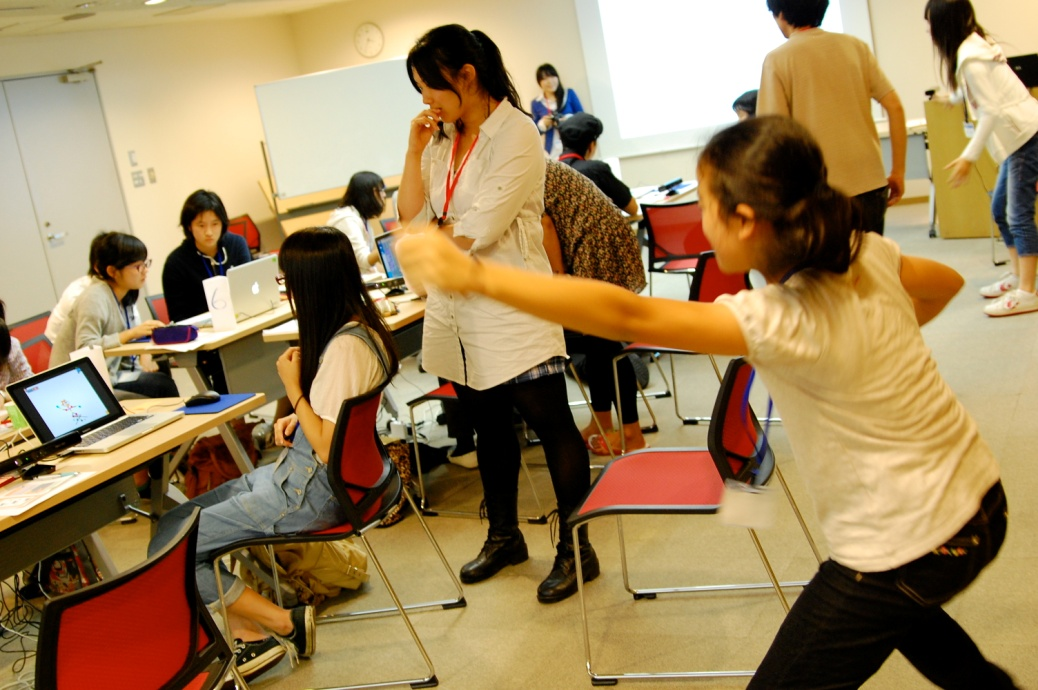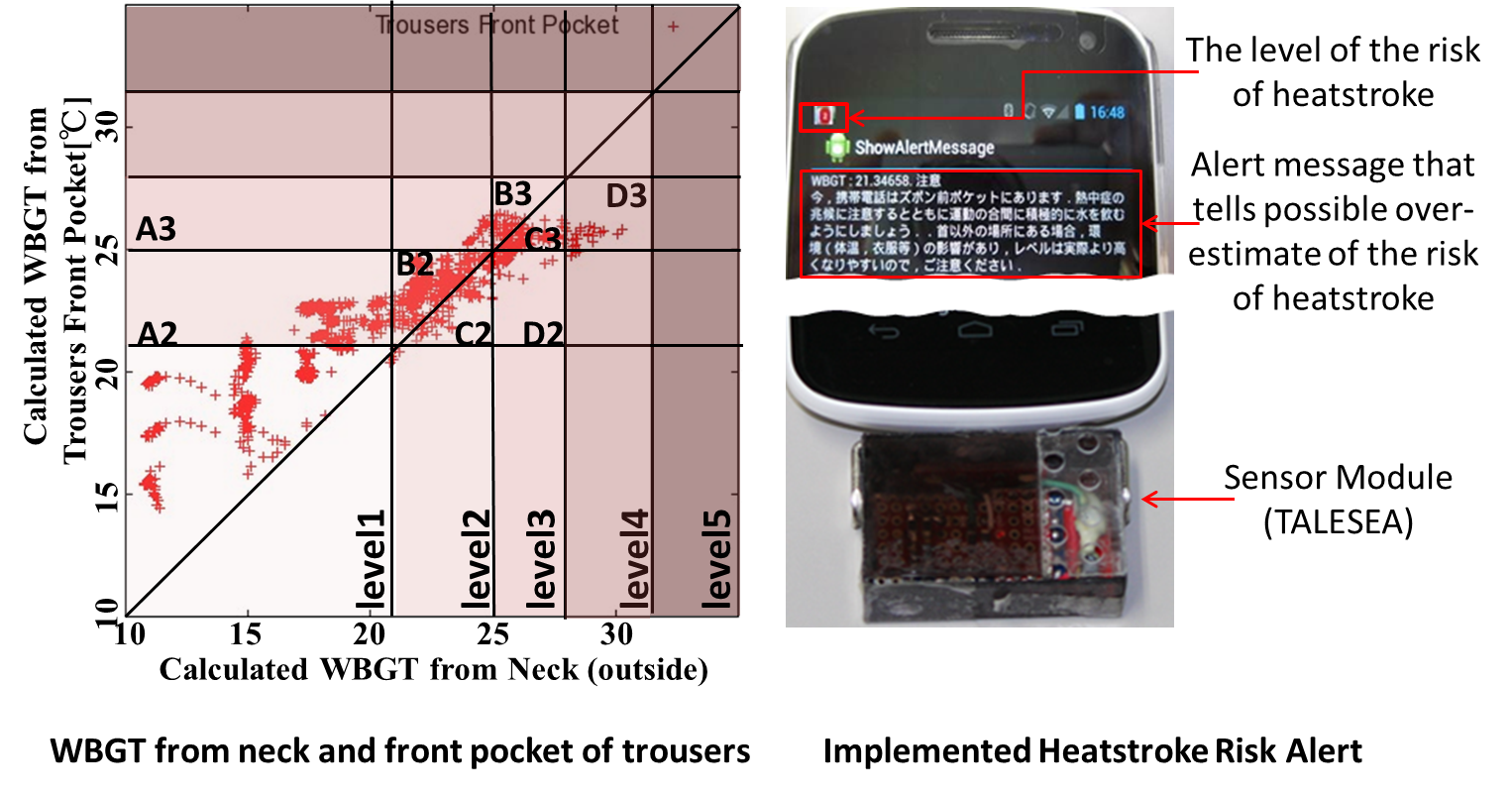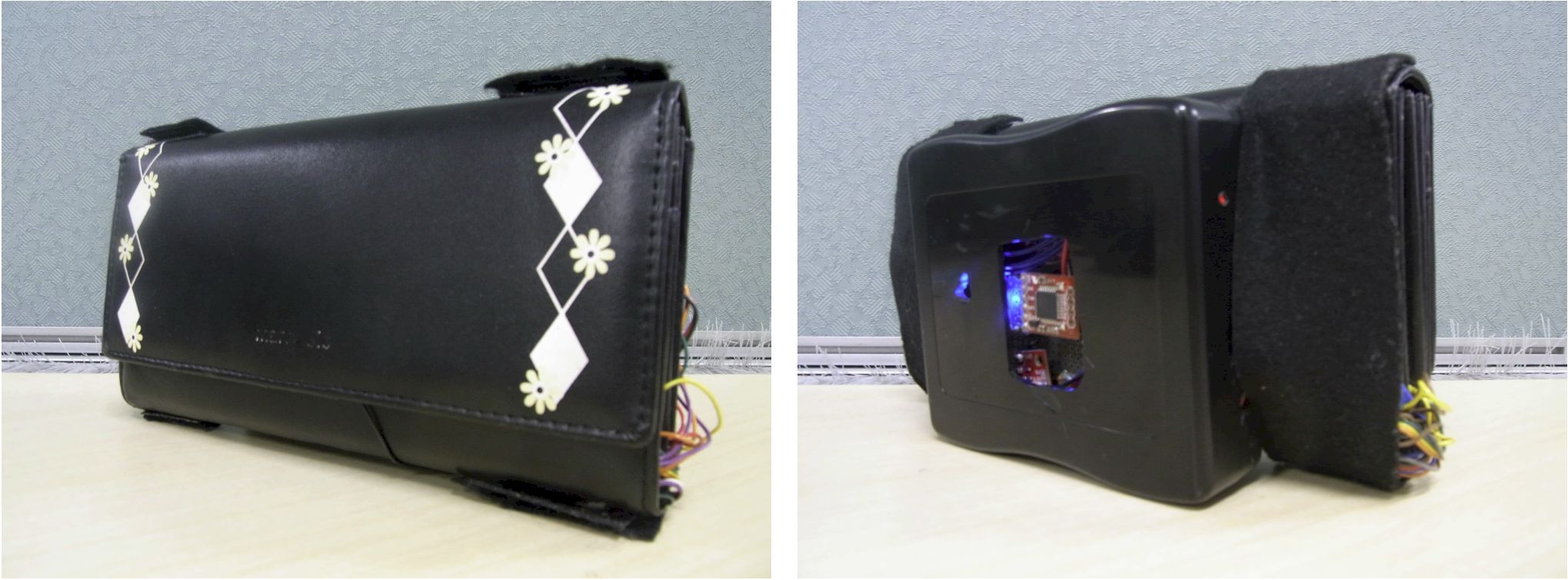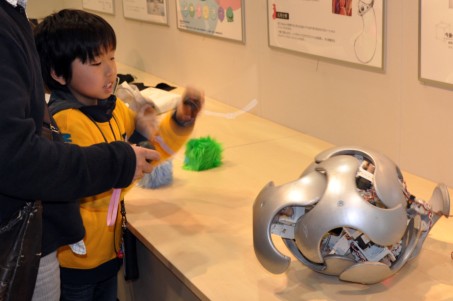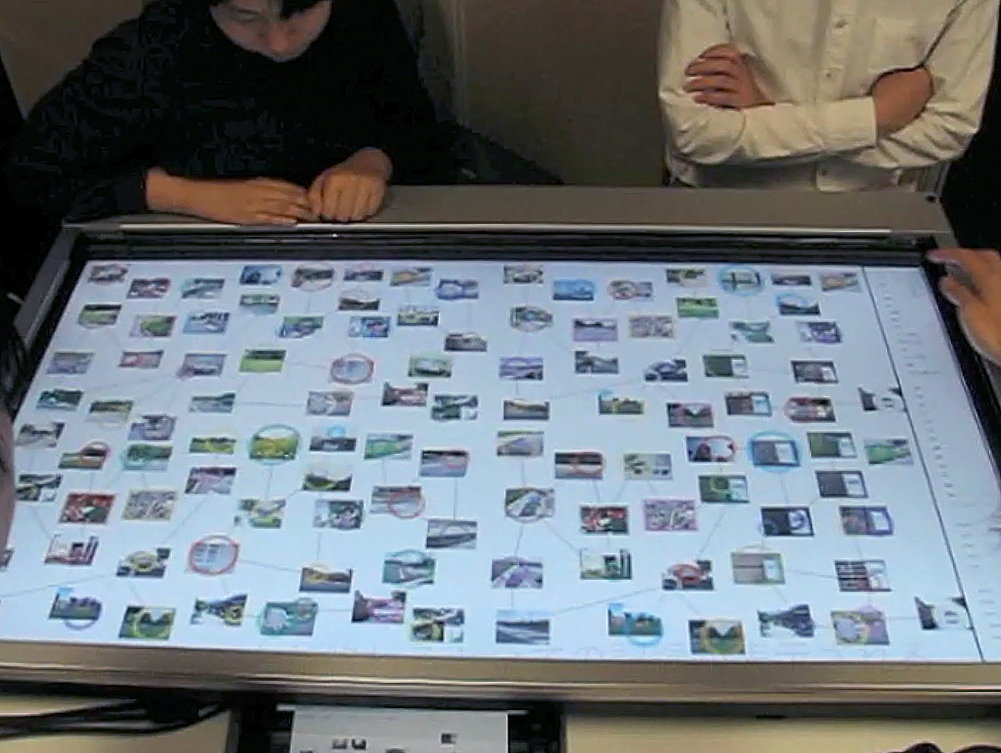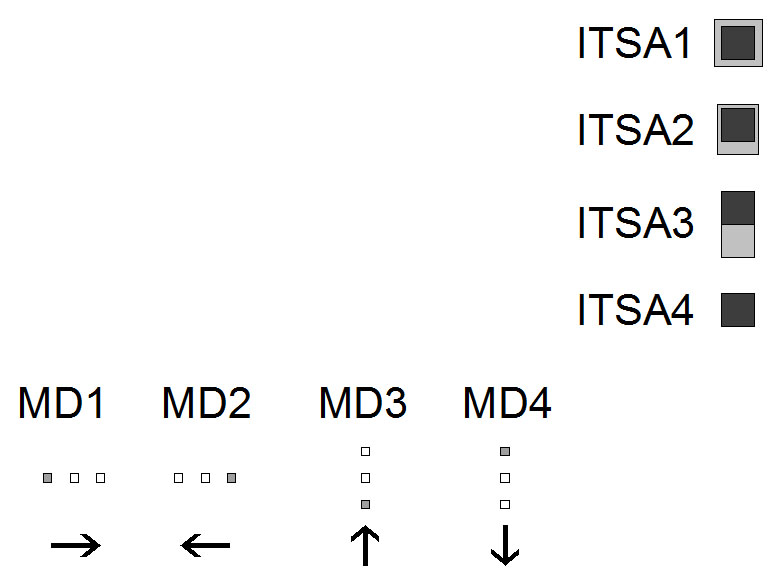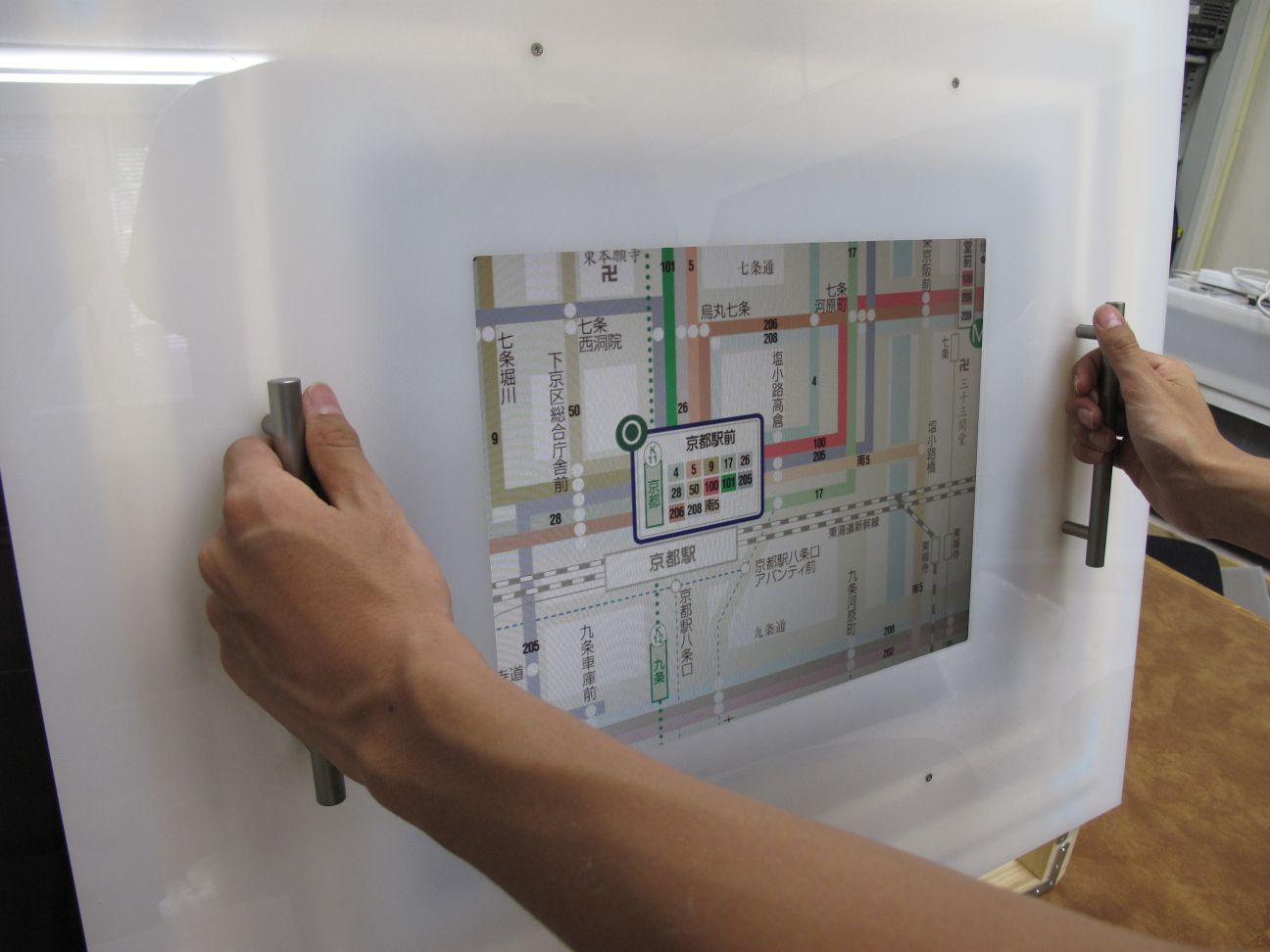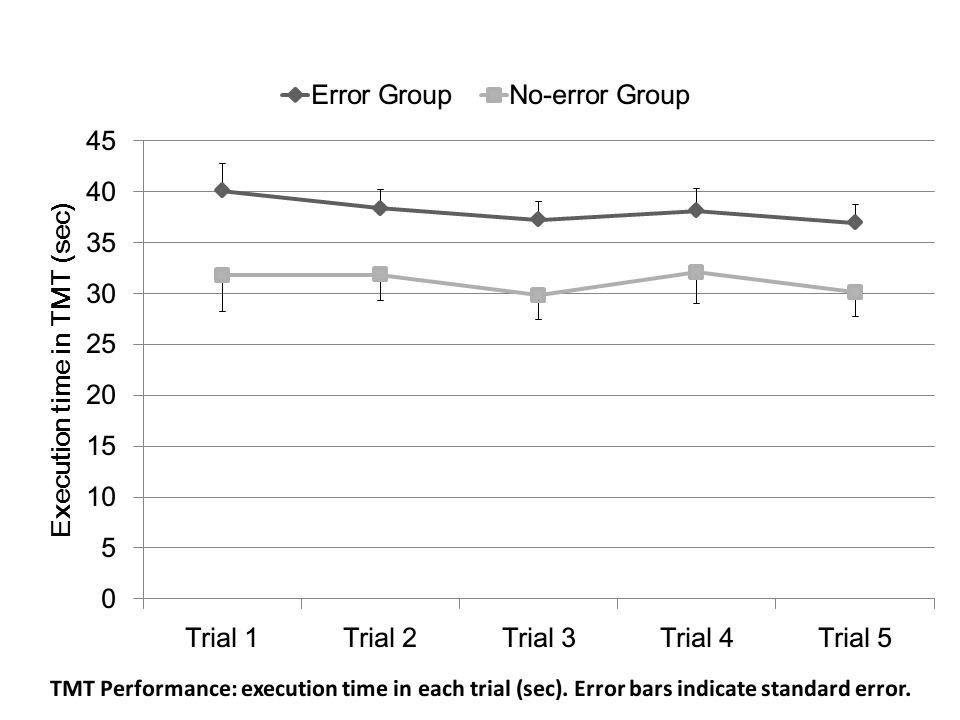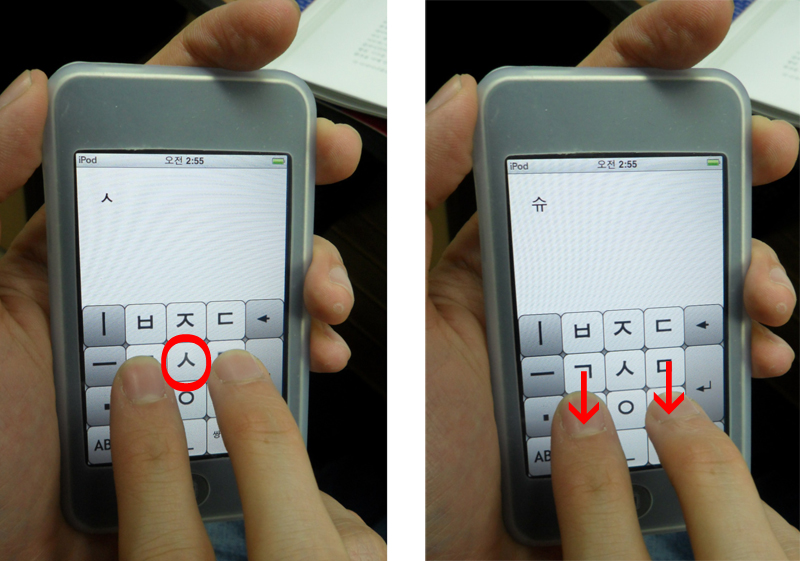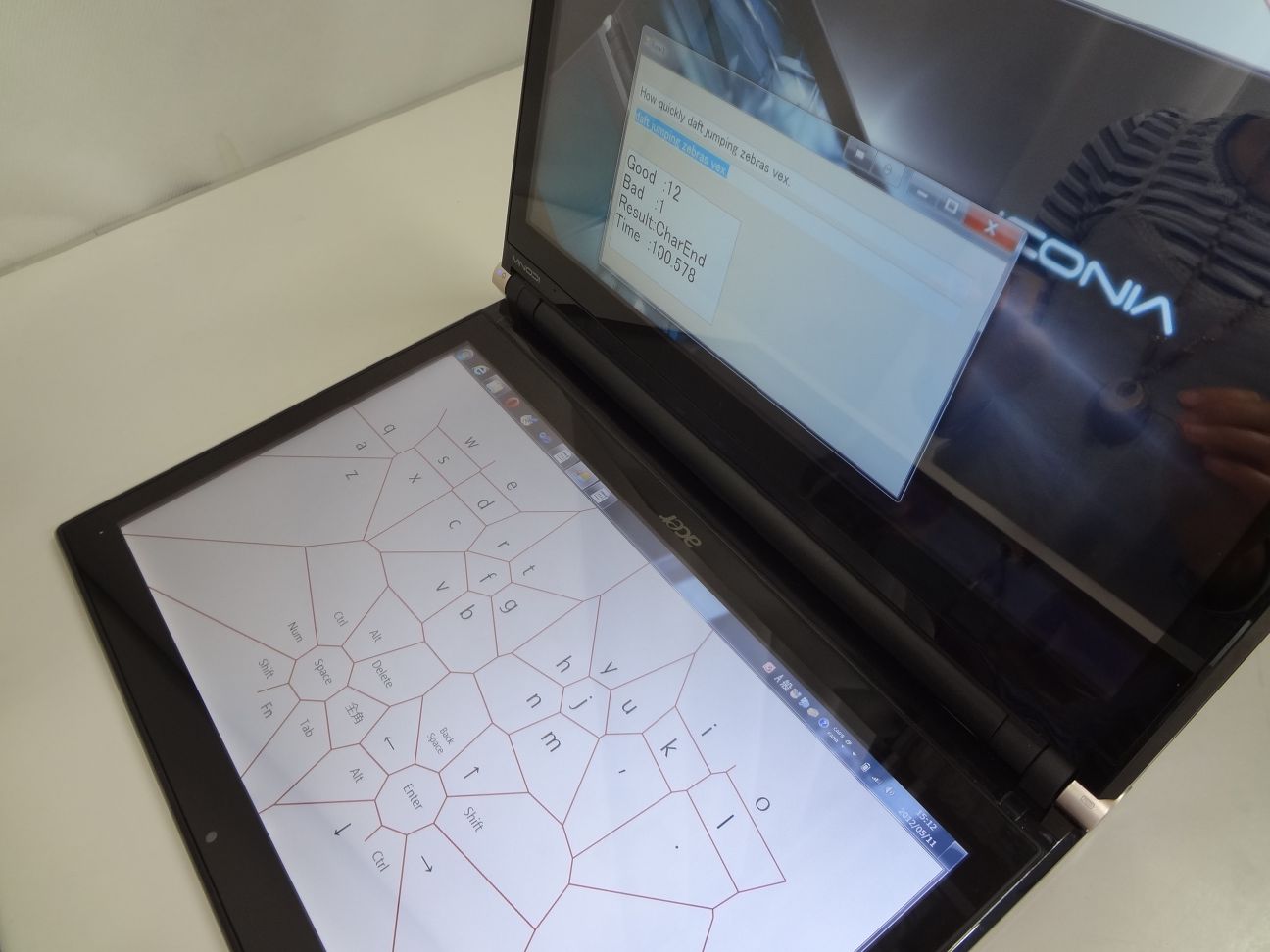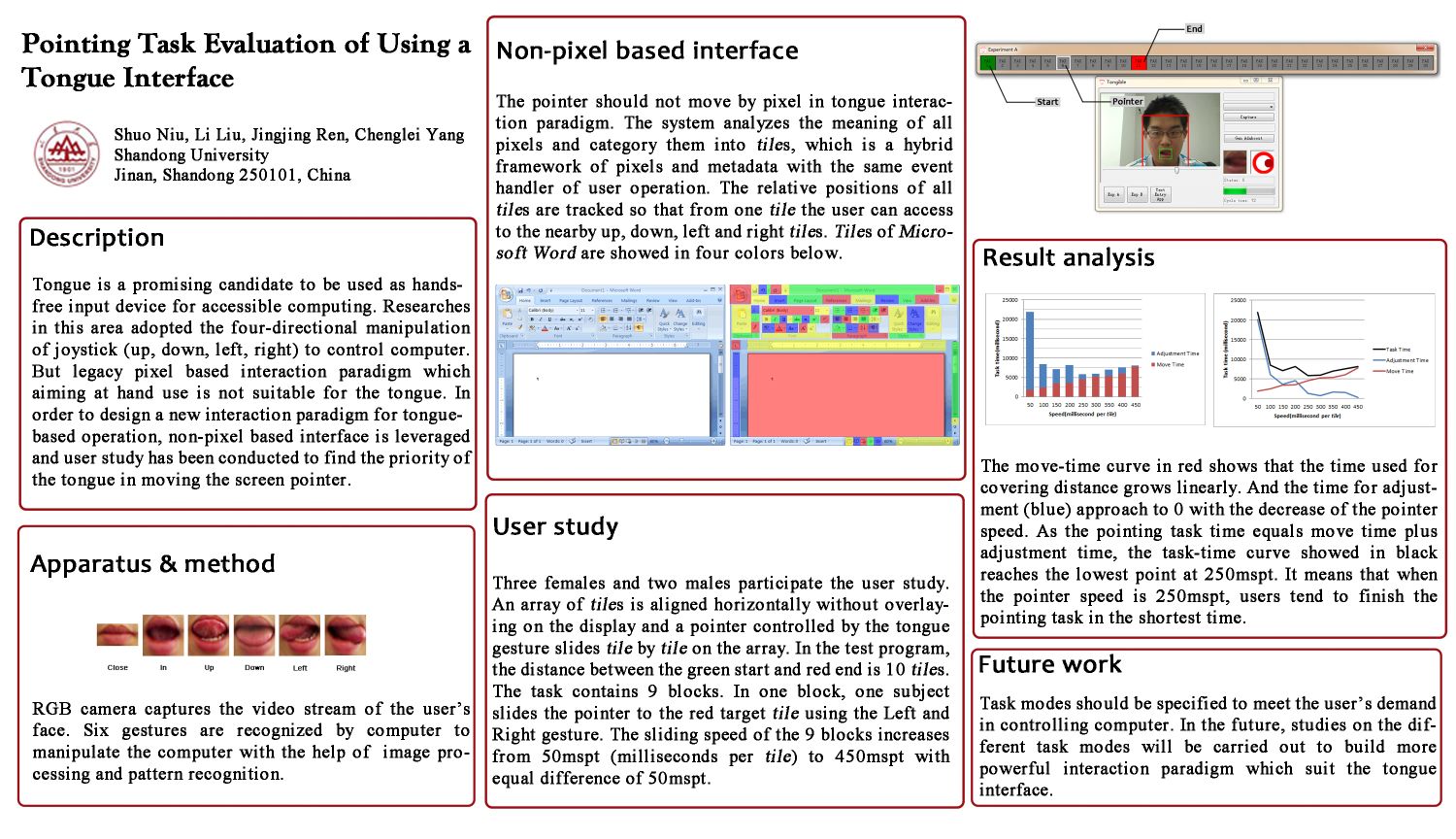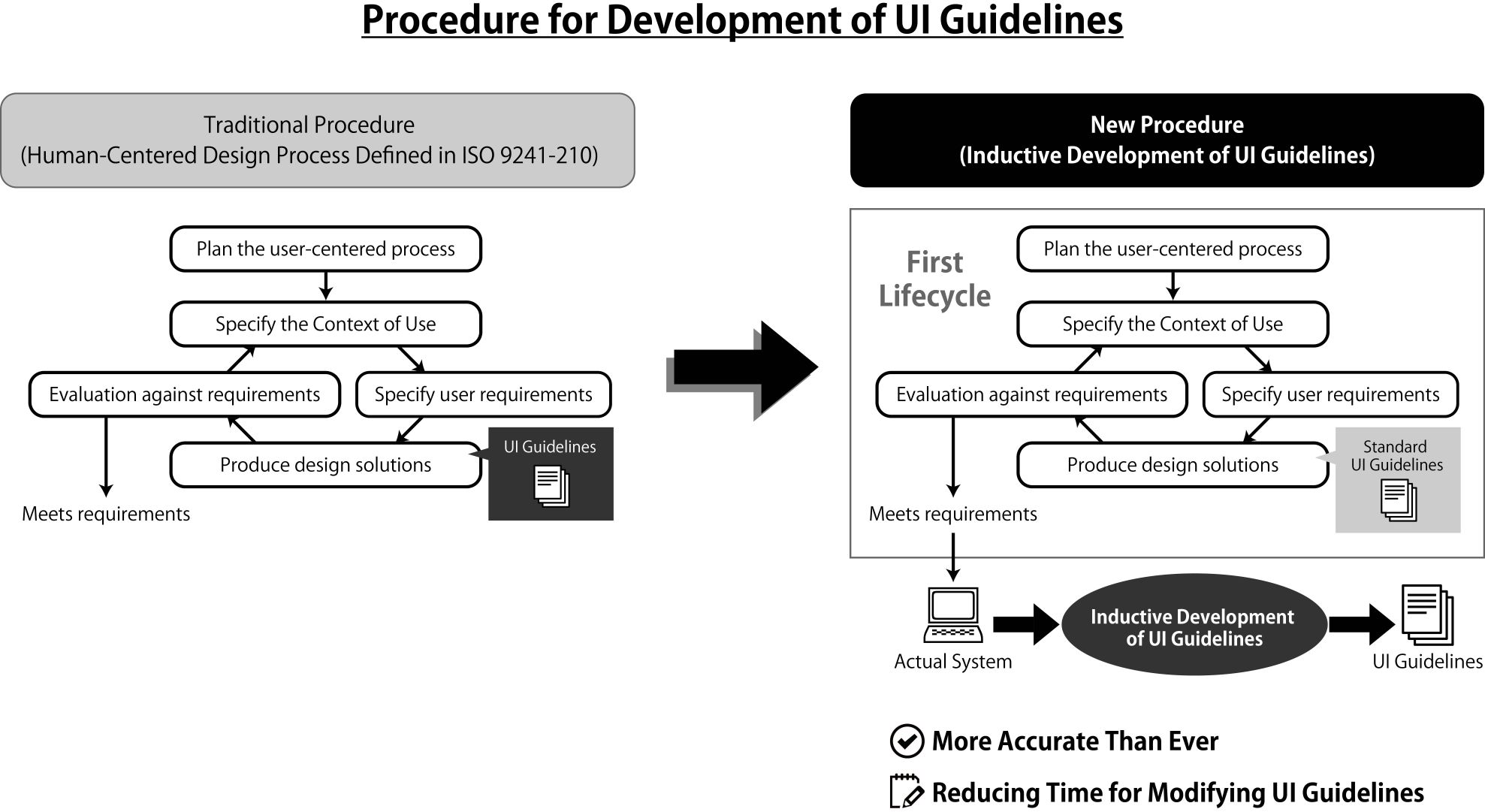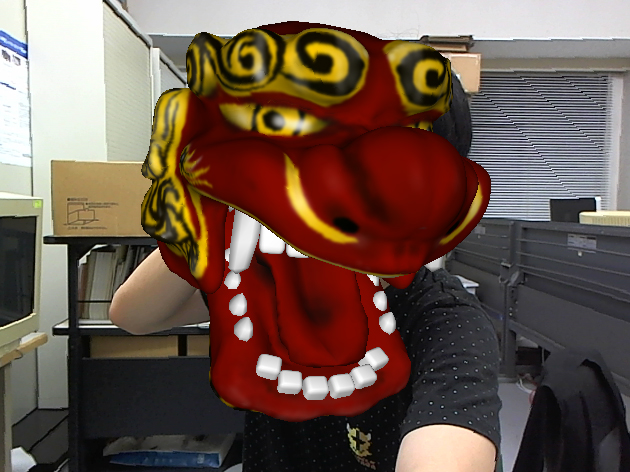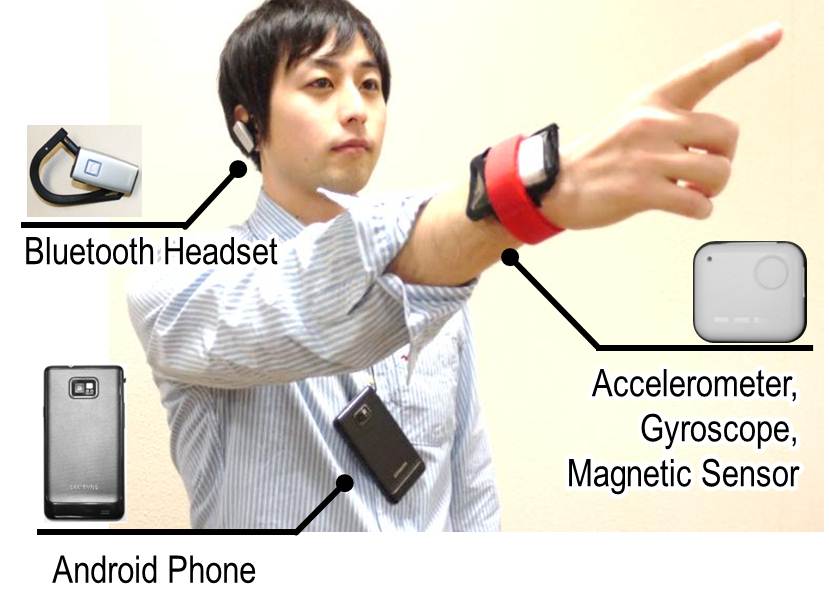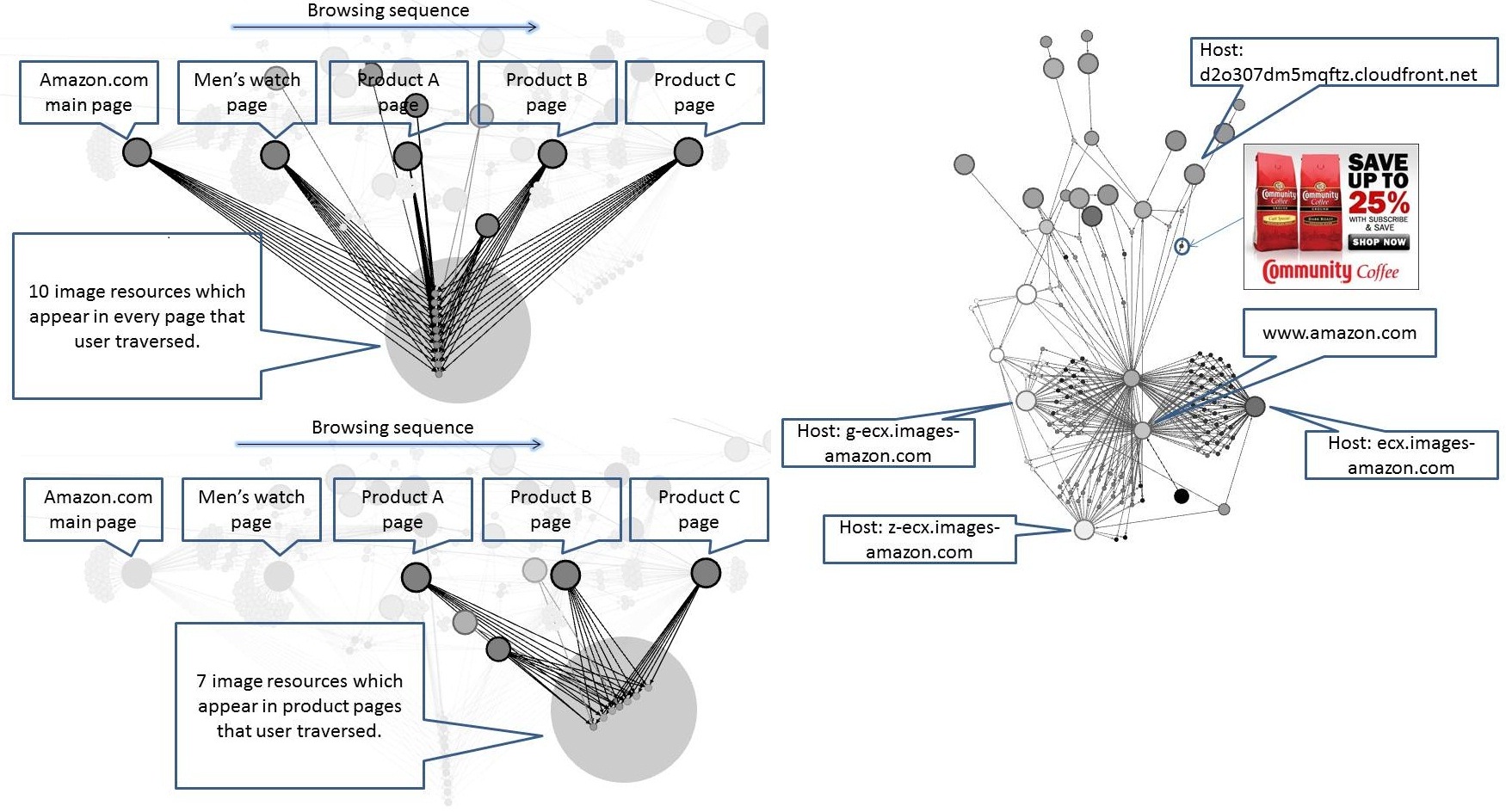APCHI2012 Poster Web Catalog
2P-01
Can Programming Concepts Learned through Physical Actions?
Nobuko Kishi (Tsuda College, Japan)
Manabu Sugiura (Tsuda College, Japan)
Kinect2Scratch has enabled us to use the Microsoft Kinect controller to control Scratch sprites with physical action, i.e. by moving arms and legs. We have found that these physical actions also make programming easier to learn through our experiences with the workshops we held for middle school girls. We present Scratch examples used in our workshops and the programs created by the workshop participants. By doing so, we would like to show how some programming concepts were understood by novice programmers without much effort and show emerging possibilities of learning programming concepts through physical actions.
2P-02
Enhancing the Experience of Yoga Practice through an Immersive Interactive Studio
Monique Park (Madeira Interactive Technologies Institute/University of Madeira, Portugal)
Mario Pinto (Madeira Interactive Technologies Institute/University of Madeira, Portugal)
Antonio Gomes (Queen's University, Canada)
Monchu Chen (Madeira Interactive Technologies Institute/University of Madeira, Portugal)
The Interactive Yoga Studio is a unique space for a yoga practitioner to achieve a deeper level of realization. This studio can be used by a regular daily practitioner, and can also be utilized for learning the poses in a more accurate way and encourages longer holdings of the each poses. The interactive visuals not only keeps the interest constant throughout the practice, but also guides the practitioners to stay in the poses for a healthy duration.
2P-03
A Design for Communicating Private Information on Interactive Large Public Displays in Public Spaces
Shigeyoshi Iizuka (Kanagawa University, Japan)
Wataru Naito (University of Yamanashi, Japan)
Kentaro Go (University of Yamanashi, Japan)
Currently, communicating information via a public display in public spaces has enveloped to a place where it is now performed more frequently. However, even whether the public interface environment must be designed for a user to communicate in a public space, it is not clear what kind of environment would be most suitable for communicating confidential information. We launched a study that derives the indicator and the design method for such an environmental design of an interactive public display in a public space.
2P-04
A Methodology Plan for Cooperative Design with Parametric Computing
Hung-Pin Hsu (National Chiao Tung University, Taiwan)
"Ethnic harmony is an important issue in the local culture development. Due to the particularity of the geographical and historical context, Taiwan culture is formed with many races. Among, the new race culture is more dominant than the aboriginal culture in Taiwan.
With the enhancement of functions of computer and the progress as well as popularization of internet technology, the applications of computer systems are getting transformed from individualized into distributed type gradually. Due to the multitudinous semi-structured and unstructured problems, users must rely on collaborative communication to look for the solutions. Therefore, users pay more and more attention to the computer supported cooperative system.
In this research, we use the parametric computing to explore the possibility of combining the aboriginal culture on the window lattice of dominant race. And the method of parametric computing provides a new method for designer to generate a new architectural expression with their cooperators. "
2P-05
A System for CSCW in a Chaotic Situation: The Case of Overcrowded Event Hall
Yasuhiro Takashita (Tokai University, Japan)
Kayo Iizuka (Senshu University, Japan)
Yasuki Iizuka (Tokai University, Japan)
Although cooperative actions are required for refuge and rescue in times of disaster, executing such actions is often very difficult because of the chaotic nature of the situation. In order to address this issue, we applied computer supported cooperative work (CSCW) system to the cooperative group action at an event hall where the problem of overcrowding occurs often. The major functions and features of the proposed system are described in this paper together with the result of the evaluation obtained through the experiment of the prototype system.
2P-06
A Trustworthy Heatstroke Risk Alert on a Smartphone
Yuan Xue (Tokyo University of Agriculture and Technology, Japan)
Shigeki Hosokawa (Tokyo University of Agriculture and Technology, Japan)
Satoshi Murata (Tokyo University of Agriculture and Technology, Japan)
Satoshi Kouchi (Tokyo University of Agriculture and Technology, Japan)
Kaori Fujinami (Tokyo University of Agriculture and Technology, Japan)
In Japan, various consumer products for heatstroke risk alert have been available on the market, in which Wet-Bulb Globe Temperature (WBGT) is utilized as a heat stress index. An issue in such a portable environmental measurement device is that the measurement might not be correct if the instrument is not outside, such as in the pocket. The over-estimate from the incorrect measurement may lead to a user's distrust due to frequent warning, while under-estimate might cause a severe damage on the user. To address the issue, we propose a trustworthy and effective heatstroke risk alert device that provides a user with possibility of over (under)-estimate based on a storing position on body as well as the level of the risk.
2P-07
A User Behavior Analyzer for a Public Transit Navigation System
Genki Kenjo (Tottori University, Japan)
Masaki Ito (Tottori University, Japan)
Taro Kawamura (Tottori University, Japan)
Kazunori Sugahara (Tottori University, Japan)
We developed the analyzer of users' behavior for a public transit navigation system in order to improve the usability and find the required functions. The analyzer records users' situations and behaviors, such as the page transitions, searched routes, device type. To take advantage of these data, the analyzer illustrates graph of the usage trends and the result of the evaluation of the usability.
2P-08
A User Interface Using a Spiral Representation for Image Retrieval on a Mobile Terminal
Hiroki Yamamoto (Shinshu University, Japan)
Hidetoshi Miyao (Shinshu University, Japan)
Minoru Maruyama (Shinshu University, Japan)
To efficiently visualize a set of images for a similar image search system on a mobile terminal which is equipped with a touch screen, we propose a method that ranked images are represented in a spiral manner and they can be dragged along the spiral for finding a target image. We also propose efficient search operations for the system. As a result of comparison experiments between our system and a traditional one, evaluations of our system in terms of 'intuitive', 'beauty', 'fun', and 'novelty' were higher than those of traditional one.
2P-09
Acceptability Engineering: Towards a New Discipline for Acceptable Innovative Technologies Design
Hee-Cheol Kim (Inje University, Republic of Korea)
Innovative technologies are future technologies that can radically transform our ways of living and lead to new lifestyles through their use. In particular, the success of innovative technologies requires more specific attention on early adopters or technical enthusiasts, as opposed to general end-users. User acceptance should also be considered more than usability. Presently, little is known about ways of evaluating future innovative technologies from the user acceptance perspective. Recognizing a demand for theories and methods for acceptable innovative technologies design, this paper proposes a potential discipline of Acceptability Engineering (AE) as an academic space where concepts, theories, and methods can be generated, shared, and validated among researchers.
2P-10
Affects of Psycho-physiological Stress on Working Memory in Young and Old Adults
Viet Lai (University of Occupational and Environmental Health, Japan)
Chalermsiri Theppitak (University of Occupational and Environmental Health, Japan)
Yoshiyuki Higuchi (University of Occupational and Environmental Health, Japan)
Mehrnoosh Movahed (University of Occupational and Environmental Health, Japan)
Ganga Kumudini (University of Occupational and Environmental Health, Japan)
Hiroyuki Izumi (University of Occupational and Environmental Health, Japan)
Masaharu Kumashiro (University of Occupational and Environmental Health, Japan)
The present study investigated the effects of psycho-physiological stressors on memory performance in young and old adults. Twelve young and 12 old healthy males were submitted to a stressful condition in one day and control condition in another day. After each condition subjects performed the modified version of Sternberg task with complex visual scenes. It was found that stress impaired WM performances in young adults with lower Hit rates and lower False alarm rates (due to increasing of lucky rejected items) but didn't affect performance in elderly. The present study suggests that there are age-dependent changes in the reactivity to acute cortisol level as expressed by a negative effect of stress on WM in young but not in old subjects even old subjects had higher response of the hypothalamic pituitary adrenocortical (HPA) axis.
2P-11
An Empirical Investigation into Differences and Similarities between Age-related Stroke Gestures
Yusuke Hayashi (Kochi University of Technology, Japan)
Huawei Tu (Kochi University of Technology, Japan)
Xiangshi Ren (Kochi University of Technology, Japan)
We conducted a first study to evaluate the performance of pen and finger gestures between the elderly and young people. We found that younger participants performed better than older participants in terms of stroke time, average speed and size ratio. Our study demonstrated that understanding the differences and similarities between younger adults and older adults is very important for gesture design.
2P-12
An Index Method for Evaluating the Interactivity of Ubiquitous Services Based on Interactivity-satisfaction Model
Joobong Song (Seoul National University, Republic of Korea)
Ilsun Rhiu (Seoul National University, Republic of Korea)
Byungki Jin (Seoul National University, Republic of Korea)
Myung Hwan Yun (Seoul National University, Republic of Korea)
Interaction between user and system is very important in the ubiquitous computing service environment. Also, a new method for evaluating interaction effectively in practical works is essential. The purpose of this study is to develop evaluation attributes, which can be used easily in practical works, for ubiquitous service interaction based on interaction-satisfaction model. In this study, we executed logistic regression to analyze effect of 22 interaction metrics collected from literature review on satisfaction. Then, we categorized the attributes of ubiquitous service into three perspectives: technology-oriented, cognitive-oriented, and behavior-oriented attributes, and developed metrics for each perspective. The developed metrics were verified by probability of acceptance based on data clusters collected at first. The interaction metrics suggested in this study developed the method for ubiquitous service and the importance of each attributes, and they will be helpful for service provider and a policy maker to make a decision.
2P-13
Analyzing Expenditure History on Basis of Location and Time Data Acquired Using Expense Recognition Wallet
Kenzo Nirasawa (University of Tsukuba, Japan)
Buntarou Shizuki (University of Tsukuba, Japan)
Jiro Tanaka (University of Tsukuba, Japan)
We describe our ongoing study that explores the usefulness of automatically recording expenditure history. The data recorded include the amount of money spent and the context for each expenditure, i.e., the location and time. To this end, we developed the Expense Recognition Wallet (ER-Wallet) and the MoneyLog Viewer. The former is a wallet with em- bedded circuitry that automatically recognizes the amount of money spent by the owner. The latter is an application for analyzing personal financial information geographically and temporally.
2P-14
Assisting Memory Recall of the Individuals Who Have Mild Dementia with Portable Logging Devices
Hiroki Matsushita (Ritsumeikan University, Japan)
Hung-Hsuan Huang (Ritsumeikan University, Japan)
Kyoji Kawagoe (Ritsumeikan University, Japan)
Kiyoshi Yasuda (Chiba Rosai Hospital, Japan)
With the increasing average life expectancy of world population, there are more and more dementia patients, and the needs of assistive technology emerges. We are developing a memory vest which is designed for help the dementia patients to recall the events happened in their daily life. It is equipped portable devices including an Android smartphone, two IC audio recorders, and digital video recorder to log the daily life of the patient. The gathered user activity history is stored in a database. Remarkable events are then detected and the corresponding can be browsed later.
2P-15
Association Analysis for Web Accessibility Problem on Topic Path
Hidehiko Okada (Kyoto Sangyo University, Japan)
Masaki Ogawa (Kyoto Sangyo University, Japan)
We report our experimental result of mining association rules on web accessibility problems from 100 page instances with/without their topic paths. In the extracted rules, the four JIS guidelines, #5.3e, #5.9a, #5.1a and #5.4e, appeared more. Thus, pages which violate these guidelines are likely to lack their topic paths.
2P-16
Blinklifier: The Power of Feedback Loops for Amplifying Expressions through Bodily Worn Objects
Patricia J. Flanagan (Hong Kong Baptist University, China)
Katia Canepa Vega (Hong Kong Baptist University, China / Pontifical Catholic University of Rio de Janeiro, Brazil)
Hugo Fuks (Pontifical Catholic University of Rio de Janeiro, Brazil)
The main motivation of this research is to gain a better understanding of the power of feedback loops by finding the zone somewhere between passively offering information and aggressively pumping out data that gets ignored along with all the other media noise. The answer we believe lies in creating compelling, aesthetic solutions that appeal to our senses and fuse seamlessly with our everyday lives. This poster discusses the power of feedback loops in environments where human and wearable computers are intertwined and explores their application as tools for self-modification and sustainable change. In order to explore feedback loops in these environments, we propose Blinklifier, a wearable computer that amplifies human blinking and minimizes the use of intrusive devices on the face such as heavy glasses and electromyography. Here we investigate the communication possibilities by exposing blinking through wearable computers.
2P-17
Business User Model: Proposal of Personas for BtoB (Business to Business) Product
Toru Mizumoto (Wakayama University, Japan)
A lot of product planners know the methodology and effectiveness of the persona method as very effective to improve customer's satisfaction on their products. So, the product planners want to surely use the persona method. However, the examples shown in technical books are almost only about BtoC (Business to Consumer) products. The BtoB (Business to Business) product means the instruments for office work, the machine tools, the medical instruments and the other instruments for professional use that are delivered to offices, factories, hospitals and other facilities. Because the users use them only for their works, context of use of BtoB product is different from BtoC product. Thus, Personas for BtoC product is not usable for BtoB product. Therefore, we propose personas for BtoB product. We call it the "Business User Model". We introduce the profit of using the Business User Model.
2P-18
Card-lay Style Interface - The User Interface with a Japanese Tsumiki Motif -
Hajime Kira (Japan Advanced Institute of Science and Technology, Japan)
Haruya Shiba (Kochi National College of Technology, Japan)
Takumi Yamaguchi (Kochi National College of Technology, Japan)
Kazumasa Imai (Kochi National College of Technology, Japan)
Recently, a Graphical User Interface (GUI) is commonly used to operate information devices. However, when using information devices, beginners and elderly people, who are unfamiliar with such a user interface, may find it challenging to operate a GUI. Moreover, because the input of a GUI mandates a frequent fine motion of the fingertip weak elderly people, or those with a physical handicap encounter difficulties while using it. In this study, we propose a "Card-lay style interface" that performs the information operation by sorting and combining some wireless-linked information devices. This interface derives from the "Tsumiki" building block game with a Japanese motif. Motions like sorting and combining something are commonly found in daily life. In this study, we apply these motions to information operation and design an interface that is operated by sorting and combining motions. This way we can expect to have communication and information acquisition to operate information devices not only by children who never experienced information devices but also by people who find it difficult to operate information devices because they suffer, such as people suffering from dementia. This is because the operating procedure is closer to operating procedures that can be performed on a daily basis and therefore reduce the difficulty level of learning.
2P-19
Characteristics of Pacing Disorder on Dynamic Tasks
Yuki Matsuyama (Shimane University, Japan)
Masahiko Nawate (Shimane University, Japan)
We have considered that it is necessary for people with the pacing disorder to perform dynamic tests and trainings with two dynamic objects, "passive" and "active" tasks. As the characteristics of pacing disorder, we observe that people with the disorder can not wait for dynamic target. The results are that the characteristics of pacing disorder are more notable in active task than in passive task.
2P-20
COLUMN: The Visually Mediated Interpersonal Coordination
Yasutaka Takeda (Toyohashi University of Technology, Japan)
Kohei Yoshida (Toyohashi University of Technology, Japan)
P. Ravindra S. De Silva (Toyohashi University of Technology, Japan)
Michio Okada (Toyohashi University of Technology, Japan)
The motivation of this study is to explore a user's interpersonal coordination structure toward developing a behavior generation mechanism for a Core Less Unformed Machine (COLUMN). The interpersonal coordination is generally synchronous by channeling of vocal interactions, visual, and physical interactions. However, our study explores the visually-mediated connectedness of three users (interpersonal coordination) to accomplish their desired behaviors for COLUMN.
2P-21
Comparing Sensor Based and Vision Based Techniques for Dynamic Gesture Recognition
Bayasgalan Baatar (University of Tsukuba, Japan)
Jiro Tanaka (University of Tsukuba, Japan)
Currently, there are mainly two types of techniques for hand gesture recognition: vision based and sensor based. Each technique has its own merits and restrictions and to decide which technique to use in our gesture application is difficult. In this paper, we describe comparison results for these two techniques for dynamic gesture recognition. We implemented a Google Earth Hand Gesture Navigation System for dynamic gesture recognition evaluation purpose. Our results show that vision based Dynamic FP (feature point) is best for dynamic gesture recognition.
2P-22
Context Weaver: Linking Qualitative Spatial Information for Community Mapping
Tomoyo Sasao (University of Tokyo, Japan)
Shin'ichi Konomi (University of Tokyo, Japan)
Masatoshi Arikawa (University of Tokyo, Japan)
Hideyuki Fujita (University of Tokyo, Japan)
Making sense of field data collected by different people is an inherently difficult task because of the variability of context. We propose Context Weaver, an environment for capturing, linking, and sharing qualitative spatial information along with relevant contextual information using tablet and tabletop computers. We discuss its use in community mapping workshops.
2P-23
Control of Human Generating Force by Use of Acoustic Information - Frequency-sweep Sounds for Gradually Increasing Force -
Taichi Sato (Tokyo Denki University, Japan)
Akira Goto (Tokyo Denki University, Japan)
We conducted an experiment in which experimental sounds were made to flow from a speaker and subjects were asked to perform a lifting action while listening to those sounds. We investigated acoustic information for gradually increasing lifting force. It was revealed that slowing up the speed of a frequency sweep had the effect of gradually increasing lifting force at the initial portion of a sound.
2P-24
Designing Augmentative and Alternative Communication for Autism and Stroke: Touch-to-Speak iOS Application
Areej Al-Wabil (King Saud University, Saudi Arabia)
Ghada Alofaisan (King Saud University, Saudi Arabia)
Arwa Alrubaian (King Saud University, Saudi Arabia)
Amani Musrea (King Saud University, Saudi Arabia)
Bayan Alarifi (King Saud University, Saudi Arabia)
Nora Alroumi (King Saud University, Saudi Arabia)
In this paper we describe an iOS application designed for augmentative and alternative communication (AAC). This AAC is developed specifically for children with autism spectrum disorders and stroke patients with aphasia who have speech and language impairments in Arabic populations. A User-Centered Design methodology was followed to ensure a usable AAC product that responds to the needs of these two target populations.
2P-25
Designing Novel Applications When User Requirements Are Unknown
Hyowon Lee (Singapore University of Technology and Design, Singapore)
Nazlena Mohamad Ali (Universiti Kebangsaan Malaysia, Malaysia)
This paper reflects on recently completed technology R&D projects by the authors to argue for a more explicit differentiation between designing conventional applications (as practiced in most software industry today) and designing novel applications (as practiced in research laboratories) in terms of applying usability engineering methods to guide the development of such applications. In trying to create a new line of applications that have not been tried before, an attempt to start with establishing requirements and conducting user studies is not sufficient due to the absence of user-base and practice of usage. A complementary design approach is required to maximally exploit technical possibilities and connecting them to a novel but feasible usage scenario. Such a "technically-oriented" approach is not very well-established today but will help many technology research laboratories in guiding their efforts to link their R&D output to real-world scenarios and applications as a starting point of a longer life-cycle of an application.
2P-26
Designs of User Manuals for Elderly People
Tomokazu Shimada (Shibaura Institute of Technology, Japan)
Shinya Ikeda (Shibaura Institute of Technology, Japan)
Michiko Ohkura (Shibaura Institute of Technology, Japan)
Since Japanese society continues to age rapidly, it is necessary for us to consider support methods of elderly people. Therefore, we must not only improve the design of such industrial products as IT devices but also support for the elderly so they can live safe, peaceful, and comfortable lives. As one support concerning the usability of IT devices, we focused on the design of paper-based user manuals because few researches have addressed the user manuals for IT devices for elderly people. Based on our experimental study, we propose a design for user manuals of IT devices that will support the special needs of elderly people.
2P-27
Details that Matter: A Study of the Reading Distance and Revision Time of Electronic over Dry-erase Whiteboards
Rasmus Rasmussen (Roskilde University, Denmark)
Morten Hertzum (Roskilde University, Denmark)
Electronic whiteboards are replacing dry-erase whiteboards in many contexts. In this study we compare electronic and dry-erase whiteboards in emergency departments (EDs) with respect to reading distance and revision time. We find inferior reading accuracy for the electronic whiteboard at all three levels of distance in our study. For revision time, the electronic whiteboard is slower on one subtask but there is no difference on another subtask. Participants prefer the electronic whiteboard. Given the font size of the electronic whiteboard, the inferior reading accuracy is unsurprising but the reduced possibilities for acquiring information at a glance when clinicians pass the whiteboard may adversely affect their overview. Conversely, the similar revision times for one subtask show that logon may be done quickly. We discuss how details such as font size and logon may impact the high-level benefits of electronic ED whiteboards.
2P-28
Development of Cellphone-type Tele-operated Android
Takashi Minato (Advanced Telecommunications Research Institute International, Japan)
Shuichi Nishio (Advanced Telecommunications Research Institute International, Japan)
Kohei Ogawa (Advanced Telecommunications Research Institute International, Japan)
Hiroshi Ishiguro (Advanced Telecommunications Research Institute International, Japan)
This paper presents a newly developed portable human-like robotic avatar ``Elfoid'' which can be a novel communication medium in that a user can talk with another person in a remote location in such a way that they feel each other's presence. It is designed to convey individuals' presence using voice, human-like appearance, and touch. Thanks to its cellphone capability, it can be used at anytime, anywhere. The paper describes the design concept of Elfoid and argues research issues on this communication medium.
2P-29
Development of Digital Pen-type Transparent Kana Board Communication System
Kazuyuki Itoh (National Rehabilitation Center for Persons with Disabilities, Japan)
Eye-Link type transparent Kana board, made from acrylic or other transparent materials, is utilized for people with severe physical disabilities to communicate with caregivers. In this method, the caregiver holds the transparent Kana board between him/herself and the patient; the patient spells out his/her message by gazing at each letters on the board; and the caregiver then string together the letters to understand the patient's message. Although transparent Kana board is inexpensive and the method is easy to do, it places stress on the caregiver. In this poster, we describe a developed system that uses a commercially available digital pen to lessen the workload on the caregiver.
2P-30
Diagnostics of HMI Quality
Haruhiko Urokohara (U'eyes Design Inc., Japan)
Naotake Hirasawa (Otaru University of Commerce, Japan)
Shuichi Kanda (U'eyes Design Inc., Japan)
We have developed HMI metrics to evaluate the usability of software products.System engineers who are not usability professional can design basic HMI by using this metrics. The HMI metrics is expected to be applied for the Software Quality Auditing System in the future.
2P-31
Difference between Evaluators and Users in Remote Asynchronous Web Usability Evaluation
Noboru Nakamichi (Nanzan University, Japan )
Toshiya Yamada (NTT IT Corporation, Japan )
Mikio Kiura (Canon Inc., Japan )
Susumu Kuriyama (Mitsue-Links Co., Ltd., Japan )
Hidetake Uwano (Nara National College of Technology, Japan )
remote asynchronous Web usability evaluation is being put into place. We experimented for comparing between users' evaluation and evaluators' evaluation. From comparison result, it is difficult to evaluate same evaluation for evaluators. But a usability expert in evaluators has a correlation with users' evaluation. And his evaluation only is not over-evaluating.
2P-32
Distance Measurement by a FIR Thermal Imaging Camera
Shinji Kajiwara (Kinki University, Japan )
Accident statistics show that driving at night is relatively dangerous than during the day. A thermal imaging camera that used far infrared produces an image based on the differences in thermal radiation that an object emits. This is used to guide drivers driving at night. Unfortunately one thermal imaging camera cannot measure the distance between the objects. Then, it was tried to measure the distance by the infrared using the filter that absorbed the spectra of carbon dioxide.
2P-33
Effect of Combinations of Background Colors and Letter Colors and Illumination Conditions on Readability
Yuko Matsui (Institute of Nuclear Safety System, Japan )
Hiroko Ohuchi (Japan Color Research Institute, Japan )
In this paper, we describe the effects of lighting types, illuminance levels, and combinations of background colors and letter colors on readability of letters. Using 105 color combinations of the Landolt rings and background, we tested participants' visual acuity. Each of four types of lighting was set to 500 lx and then 50 lx for the test. The results showed: (1) the combination of yellow background and white letters had low readability under all experimental conditions; (2) black letters on backgrounds of red, orange, yellow, and green (500 lx) and red letters on backgrounds of orange (500 lx) and yellow had high readability; (3) the daylight LED lamp often led to different results from those obtained for other lighting types.
2P-34
Effect of Invisible Touch Sensitive Area and Movement Direction on Touch User Interface Target Acquisition
Jeong Min Kim (Chiba University, Japan )
Hong Kue Lee (Chiba University, Japan )
Keita Ishibashi (Chiba University, Japan )
Koichi Iwanaga (Chiba University, Japan )
In this paper we describe the effect of three different types of Invisible Touch Sensitive Area (applied around the edges of the touch button) on time performance and input accuracy. The results showed that the Invisible Touch Sensitive Area evenly distributed around the edges of the touch button showed the best time performance and input accuracy. Interestingly we have found that the different movement direction of target button acquisition showed significantly different time performance.
2P-35
Effects of Binocular Disparity on the Perception of Depth Structure
Hiroaki Shigemasu (Kochi University of Technology, Japan )
Ikuko Tsubaki (Sharp Corp., Japan )
Mikio Seto (Sharp Corp., Japan )
Hisao Kumai (Sharp Corp., Japan )
We examined effects of disparity manipulation on the perception of depth structure for the purpose of effective 3D presentation. The results showed that while manipulation of the degree of depth gap between object and background did not affect the perception of depth structure within object, increase of disparity within object had a significant effect on the perception of depth structure.
2P-36
Emoballoon
Kosuke Nakajima (Osaka University, Japan )
Yuichi Itoh (Osaka University, Japan )
Yusuke Hayashi (Osaka University, Japan )
Kazuaki Ikeda (Osaka University, Japan )
Kazuyuki Fujita (Osaka University, Japan )
Takao Onoye (Osaka University, Japan )
"We propose a balloon-shaped interface ""Emoballoon"" that can recognize the types of touch interactions with a balloon such as rubbing, hugging, and so on. Emoballoon contains some sensors to recognize such user's interactions and LED to present visual feedbacks. Its elastic soft surface accepts strong and rough actions including slapping or tight hug, and presents passive force feedback depending on changes of the shape unlike conventional rigid interfaces. We found that the balloon-shaped interface implemented by simple configuration can distinguish 8 touch interactions with 70 % accuracy. "
2P-37
Enhancing Foot Movement Motor Module in ACT-R Cognitive Architecture
Jaeeun Park (Korea University, Republic of Korea )
Rohae Myung (Korea University, Republic of Korea )
The Adaptive Control of Thought-Rational (ACT-R) cognitive architecture represents only a hand-performed action of a user via a motor module. However, in many cases, a foot is used to interact with a system instead, such as in the acts of driving a car, adjusting product line in a factory, controlling dental instruments, and using surgical systems. Therefore, Fitts' law was used to develop the foot module to represent a human foot-performed action. As a result, the foot module was found to closely simulate foot-performed actions with = 0.987. In addition, the foot module also well represented two different foot movement patterns of ballistic (not dependent on target width and distance) and visually (dependent on target width and distance) movements with respect to lower and higher ID values of Fitts' law, respectively.
2P-38
Evaluation of Pointing and Clicking Techniques for Freehand Spatial Input
Koki Hatada (Fujitsu Laboratories, Ltd., Japan )
Katsuhiko Akiyama (Fujitsu Laboratories, Ltd., Japan )
Iwao Otsuka (Fujitsu Laboratories, Ltd., Japan )
Kenji Nakajima (Fujitsu Laboratories, Ltd., Japan )
Masashi Uyama (Fujitsu Laboratories, Ltd., Japan )
In this paper, we describe bare hand gestural interaction techniques for selecting objects displayed on GUI (i.e. icons). Some consumer products and research offer free-hand user interfaces. They often exploit a cursor dwell time threshold to emulate clicks. In fact, there are no decisive techniques for pointing and clicking target objects with gestures that are efficient, easy to learn and less fatigable. To date there has been no research comparing which technique is more suitable. We have implemented five pointing and clicking techniques using only a commodity depth camera. We have conducted comprehensive experiments on them. We have concluded that using hand postures was the best gesture from the view of our subjective evaluations.
2P-39
Examining Characteristics of Four Mental Models
Keita Yasui (Wakayama University, Japan )
So Yanagimoto (Wakayama University, Japan )
Kana Kobayashi (Wakayama University, Japan )
Toshiki Yamaoka (Wakayama University, Japan )
The purpose of this study is to grasp the characteristics of four mental models which consist of structured and functional models. The characteristics cause designers to construct user interface with user's mental models easily. Firstly, the four mental models were decided based on the combination of the functional model and the structural model of mental model. Secondly, The four GUIs were constructed according to the characteristics of the four combination of functional model and structural model. Thirdly, the difference of four mental models was examined. As a results, the four mental models were related the system and user requirements which are related the quantity of information, efficiency and recognition. GUI designs based on mental models should be considered by them.
2P-40
Experimental Analysis of Pen and Finger Gestures in Mobile Environments
Masashi Okamoto (Kochi University of Technology, Japan )
Huawei Tu (Kochi University of Technology, Japan )
Xiangshi Ren (Kochi University of Technology, Japan )
We conducted a study to evaluate the performance of pen and finger gestures in mobile environments, in which participants were instructed to draw a set of stroke gestures by means of the pen, index finger and thumb respectively while holding a touch-based mobile phone. We found that the pen resulted in shorter time and higher speed than the index finger in drawing stroke gesture, while the index finger led to shorter time and higher speed than the thumb. The pen produced smaller size than the thumb, and the thumb produced larger size than the index finger. Our study revealed differences and similarities of pen and finger gestures in mobile environments. When designing gesture-based interfaces in mobile environments, it is important to consider the differences and similarities.
2P-41
Exploring a Creative Design Language for Meaningful Interaction Design
Yi Ji (University of Tehcnology, Sydney, Australia )
This research investigates the development of a interaction design language for use by both interaction designers and users. The purpose of this research is to explore a novel interaction design pattern system which enables design of high levels of interaction experience for user in a particular interaction context. To formalize this framework, a practice-based research methodology is used to evaluate the outcome of design work focusing on how the interaction designer uses the interaction design framework to create a meaningful user's interaction.
2P-42
Exploring the Use of EEG and Eye Tracking in Understanding Customer Experiences for Service Design
Veranika Lim (Madeira Interactive Technologies Institute, Portugal )
Monchu Chen (Madeira Interactive Technologies Institute/University of Madeira, Portugal )
Evangelos Niforatos (Madeira Interactive Technologies Institute, Portugal )
Rui Alves (Madeira Interactive Technologies Institute, Portugal )
Evangelos Karapanos (Madeira Interactive Technologies Institute/University of Madeira, Portugal )
Nuno Nunes (Madeira Interactive Technologies Institute/University of Madeira, Portugal )
Current customer journeys only rely on qualitative data. The aim of this paper is to introduce quantitative measures of customer experiences for Service Design. An EEG and eye tracker to measure attention levels and eye behaviour were used in a case study to compare two scenarios of a customer journey. Although more research needs to be conducted, the quantitative data showed differences in attention level patterns between touchpoints for the two scenarios. This data is expected to lead to a better understanding of customers' experiences throughout the service, new customer journey visualization methods and improvements in service design deliverables.
2P-43
Gaze Analysis Tool for Evaluation of Web Site Usability
Takuo Matsunobe (Wakayama University, Japan )
Evaluation of Web usability with the help of gaze information involves plotting the gaze locus and estimating the gaze duration for an image on a Web page. From the output image, an evaluator can determine the browsing order and time for a Web page. In this method, input is required from the observer (at the position of the gaze) and the evaluator. Therefore, considerable time is required for analysis. However, evaluation of Web usability is often performed at limited cost. The proposed tool uses HTML features to automatically identify the objects viewed by an observer. In an HTML document, a DIV tag is often used to separate the content areas according to a specific style. The output of the tool is the gaze area and gaze time in a time series. The features of each content area are compared. Thus, by using the proposed tool to evaluate Web page and Web site usability, gaze information, which was analyzed qualitatively earlier, can be analyzed quantitatively.
2P-44
Gaze-communication for Individuals with Severe Motor Disabilities
Areej Al-Wabil (King Saud University, Saudi Arabia )
Bushra Al-Kadhi (King Saud University, Saudi Arabia )
Lujain Al-Tamimi (King Saud University, Saudi Arabia )
May Al-Humaimeedi (King Saud University, Saudi Arabia )
Etessam Al-Hazza (King Saud University, Saudi Arabia )
Arwa Al-Issa (King Saud University, Saudi Arabia )
iWriter is an Arabic gaze-communication system that is operated entirely by eye gaze and provides two communication modalities; virtual keyboards and a set of assistive images that illustrate the frequently used phrases for addressing the basic needs of individuals with severe motor disabilities. In this paper we describe the initial design of iWriter, an Augmentative and Alternative Communication (AAC) system designed with an Arabic interface that aims to assist people with severe motor disabilities in communication.
2P-45
Gender and Internet Use: A 10-year Follow-up
Jeff Gavin (University of Bath, United Kingdom )
Richard Joiner (University of Bath, United Kingdom )
Mark Brosnan (University of Bath, United Kingdom )
We reported a study conducted in 2002, which found gender differences in the use of the Internet. In the last ten years the Internet has changed considerably. We therefore conducted a follow up study in 2012, involving 501 undergraduate students (389 female, 100 males, 12 unspecified gender). We found a number of gender differences in participants' use of the Internet, consistent with the previous study. There was no gender difference in terms of the age they started using the Internet or hours of Internet use in a day, however, males' total use of the Internet was higher than females'. Furthermore, there were a number of differences in the way males and females used the Internet. Males were more likely to use the Internet for games and entertainment purposes. Females were more likely to use social network sites and use the Internet more for leisure activities. In terms of communication, females were more likely to use email and telephone over the web than males, whereas males were more likely to use chat and newsgroups than females. Differences in the use of the Internet are still evident in 2012 and had not disappeared or been reversed. This is contrary to the predictions of the 'digital natives' concept.
2P-46
Gestyboard: A 10-finger-system and Gesture Based Text Input System for Multi-touchscreens with No Need for Tactile Feedback
Tayfur Coskun (Technische Universitaet Muenchen, Germany )
Eva Artinger (Technische Universitaet Muenchen, Germany )
Lorenzo Pirrilli (Technische Universitaet Muenchen, Germany )
Daniela Korhammer (Technische Universitaet Muenchen, Germany )
Amal Benzina (Technische Universitaet Muenchen, Germany )
Claudia Grill (Technische Universitaet Muenchen, Germany )
Andreas Dippon (Technische Universitaet Muenchen, Germany )
Gudrun Klinker (Technische Universitaet Muenchen, Germany )
This paper presents a new text-entry approach for multi-touch devices based on both the 10-finger-system and a unique gesture-to-key mapping to overcome the lack of tactile feedback on touchscreens. We use unique gestures for all 10 fingers based on the QWERTY layout. There are two classes of gestures: Taps and Slidings. Taps activate the keyboards central home keys while slidings are used for the remaining neighboring letters. The idea behind this is to perform the gestures without looking at the ``virtual keyboard'' and without tactile feedback. By coupling the gestures to the highly efficient 10-finger-system the performance of the text entry can also be improved. We developed a first prototype, called Gestyboard, and conducted an evaluation with 41 pupils who were familiar with the 10-finger-system. Through this evaluation, we are aiming to investigate the potential usability of the first Gestyboard prototype. The results revealed that despite the complexity of the finger gestures, the users were able to perform the text entry with our prototype, and the results also highlighted additional improvements to increase the performance of our concept. The Gestyboard prototype showed a large acceptance and enthusiasm among the users. This concept has been developed within the scope of the SpeedUp project.
2P-47
Grab and Slide: A Slide-based Scrolling Interface
Yuichiro Kinoshita (University of Yamanashi, Japan )
Masahiro Takayanagi (University of Yamanashi, Japan )
Current information kiosk terminals mainly use a touch screen on which users touch buttons to scroll large size content, such as a map. To achieve a quick, direct, and intuitive scroll operation, this study proposes an interface based on the slide operation of a display. When a user grabs the handles placed on a display frame and slides the display, the magnetic sensors on each side of the frame detect the slide. The content on the display is scrolled according to the amount of the slide and its direction. A user study of a prototype of this interface was conducted using ten participants. The results of three types of tasks demonstrated that the proposed interface provides quick and easy scrolling.
2P-48
Hand Controller : Image Manipulation Interface Using Fingertips and Palm Tracking with Kinect Depth Data
Unseok Lee (University of Tsukuba, Japan )
Jiro Tanaka (University of Tsukuba, Japan )
We present a hand controller interface for image manipulation by using fingertips and palm tracking with Kinect depth data. The hand controller interface makes interactions by detecting the number of fingertips hand gestures. Our interface provides resizing, rotating, and dragging interactions with images. As a result, our system has implemented a natural user interface for image manipulation.
2P-49
Haptic Interaction for Uneven Textures on Surface in 3D Objects Using SPIDAR-mouse
Kikuo Asai (Open University of Japan, Japan )
Makoto Sato (Tokyo Institute of Technology, Japan )
In this paper we describe a haptic interaction system for uneven textures on surfaces in 3D objects using the SPIDAR-mouse. We have some situations that even physical objects exist, but holding or touching the objects is not allowed at such exhibits in museums because they are not tolerant for the physical holding or touching. We developed a prototype system enabling a user to feel tactile feedback on the surface in the objects by deriving depth information from the Kinect sensor and presenting a lateral force with the SPIDAR-mouse.
2P-50
Higher Workload and Higher Brain Activity Caused by Application of Separate Visual Information via Each Eye.
Hiroyuki Izumi (University of Occupational and Environmental Health, Japan )
Yoshiyuki Higuchi (University of Occupational and Environmental Health, Japan )
Masaharu Kumashiro (University of Occupational and Environmental Health, Japan )
Human recognize many information like a distance perception by visual information processing using visual cues from binocular vision. It is presumed that a greater workload is induced when unusual visual cues are given. The monocular head-mounted display (mono-HMD) has many features such as hands free, small size and lightweight, portability, and wide field of view. However, an abnormal situation whereby the worker sees different sights with each eye will occur when using mono-HMD. The purpose of this study was to obtain information on mental workload during mono-HMD use. The image cognition task under conditions of concurrent use of a mono-HMD (dominant eye) and normal desktop display (non-dominant eye) was used to evaluate mental workload, and the same task using a normal desktop display alone was used as the control condition. The differences in mental workload between the two conditions were considered. Task performance (the time to perform a task and the error rate), NASA-TLX, subjective evaluation of eye fatigue, the amount of oxygen in the blood at the brain surface, heart rate, amplitude of blood volume pulse (BVP) were used to evaluate the mental workload induced by using mono-HMD. Comparisons of these indexes between the two conditions showed clearly that mental workload under mono-HMD conditions were higher than under normal conditions.
2P-51
Human Error and Cognitive Function of Middle-aged Workers in Automobile Assembly Line
Yoshiyuki Higuchi (University of Occupational and Environmental Health, Japan )
Hiroyuki Izumi (University of Occupational and Environmental Health, Japan )
Masaharu Kumashiro (University of Occupational and Environmental Health, Japan )
Aging can affect cognitive function. It is possible that the human error is related with cognitive function, especially in middle-aged workers. This study analyzed cognitive function tests data which was obtained from a field study in automobile assembly line workers (n=58). This study employed Trail Making Test (TMT) and Sternberg Short-Term Memory Test (SSTM). As a result, the execution time of TMT in the workers who reported human error or near-misses (Error group) was longer than that of the workers who did not report any human errors or near-misses (No-error group). Also, the response time of SSTM in Error group was longer than that of No-error group. However, there was no significant difference of accuracy of these cognitive tests. These results suggest that incidence of near-misses or human errors in middle-aged workers can cause by speed of process or response in cognitive functions.
2P-52
Integration of Information Sharing and Casual Communication Using Twitter
Mitsuru Minakuchi (Kyoto Sangyo University, Japan )
Tatsuya Hiwatari (Kyoto Sangyo University, Japan )
Yu Suzuki (Kyoto Sangyo University, Japan )
Many information-sharing Web services, such as calendars and photo albums, are available. However, they have problems; one problem is that they provide separated communication channels from each other. Another problem is that user interfaces are differ depending on services and devices. We thus propose a unified communication channel that uses Twitter as user interface to integrate information sharing services. Users can use Web services by sending command-formatted tweets to an agent account. The agent account also tweets for feedbacks from time to time. These open tweets can activate group communications via information sharing services.
2P-53
Interactive Pong: Learning and Practicing Interaction Design through Interactive Prototyping
Yanrui Qu (Beijing University of Technology, China )
Wei Liu (Delft University of Technology, Netherlands )
Aadjan van der Helm (Delft University of Technology, Netherlands )
Walter Aprile (Delft University of Technology, Netherlands )
With interaction design being introduced at the Beijing University of Technology, for the first time interactive prototyping skills become important for their students to learn and practice. This study aims to demonstrate novel user-product interactions by prototyping interactive input devices to play the classical computer game Pong. In an interactive prototyping workshop twelve prototypes were built and experienced. From these prototypes, experiences for initiating interaction design program based on traditional industrial design education were discussed.
2P-54
Interactive Therapy of Attention Deficit Disorders with Gaze-based Games
Areej Al-Wabil (King Saud University, Saudi Arabia )
Anfal Alomar (King Saud University, Saudi Arabia )
Khawlah Alhadlaq (King Saud University, Saudi Arabia )
Manal Alrubaiyan (King Saud University, Saudi Arabia )
Najla Alzakari (King Saud University, Saudi Arabia )
Ohood Alhamid (King Saud University, Saudi Arabia )
This poster describes an ongoing project which involves developing three interactive therapeutic games to help individuals with attention deficit disorders improve their concentration, attention and memory. The system is designed to be controlled using eye gaze as a main input method along with other input devices such as the keyboard and the mouse to enhance the complexity of controlling objects within the games and to speed up the interaction.
2P-55
Investigation of Usable Gestures for Elder People with User-defined Approach
Masatoshi Kusuba (Kochi University of Technology, Japan )
Huawei Tu (Kochi University of Technology, Japan )
Xiangshi Ren (Kochi University of Technology, Japan )
Despite growing awareness of the accessibility issues of gesture input by elder people, designers still face challenges when creating accessible gesture-based interfaces. One major stumbling block is a lack of understanding about how elder people actually use gestures. We conducted a study that compared how elder people and younger people use finger and pen gestures by means of user-defined approach. We found that the gestures defended by older adult and younger adult were similar in analogue gesture based commands, but different in abstract gesture based commands. The study demonstrated that understanding the preferred gestures of younger adult and elder adult is important for gesture design.
2P-56
KoreanShaper: One-handed Multi-finger Gesture Based Korean Inputting System
Sungjae Hwang (Korea Advanced Institute of Science and Technology, Republic of Korea )
Sangtae Kim (Korea Advanced Institute of Science and Technology, Republic of Korea )
Kwang-yun Wohn (Korea Advanced Institute of Science and Technology, Republic of Korea )
With the advent of multi-touch interface, a variety of applications taking advantage of it are being introduced, but there is still a lack of inputting systems which utilizes the characteristics of multi-touch. In this paper, we present a Korean text entry system that takes advantageof multi-touch capabilities of modern touchscreen devices. The proposed interaction is inspired by the shape and structure of the Korean script so that users can intuitively understand. We proposed this system consisting of the buttons only for consonants of the Korean alphabet to minimize the number of buttons. To resolve the low input resolution and occulsion of finger, the center point of two fingers was designed as the selective consonant and the dragging guideline were proposed for improvement of the input accuracy.
2P-57
Leyboard: A Software Keyboard That Places Keys at Positions of Fingers and Their Surroundings
Yuki Kuno (University of Tsukuba, Japan )
Buntarou Shizuki (University of Tsukuba, Japan )
Jiro Tanaka (University of Tsukuba, Japan )
In this paper, we present a software keyboard called Leyboard that provides users easy touch-typing. Traditional software keyboards are difficult for users to touch-type because users cannot sense the places of keys by touching them. Thus, we make touch-typing easier by placing keys at the positions of fingers and their surroundings. Even if keys are unperceivable, adjusting the places of keys to users' hands enables them faster and more accurate input than using ordinary software keyboards. We have implemented a prototype and have performed a user study for evaluation. The input rate of Leyboard has risen up to 31 wpm.
2P-58
Measurement of Plantar Pressure for Development of Haptic Device on Foot: Effects of Groove Width and Sole of Shoe
Yasunobu Masuda (Yamagata University, Japan )
Takehito Kikuchi (Yamagata University, Japan )
Masao Sugiyama (Yamagata University, Japan )
The final goal of this study is to develop a virtual walking system with a haptic device on feet. In this system, the development of the haptic interface for feet soles is a new challenge. Before its design, we should know the concrete goal of the plantar pressure presented by the device. In this paper, we measured the plantar pressure on feet against several groove geometries, with several types of shoes. A force sensor sheet system (F-Scan II) was used as a measurement device. Sensory evaluation tests and evaluations of the plantar pressure were conducted. According to the results, although there are some differences on shoes, the just noticeable difference (JND) of width of the groove under sole feet is 2 ~ 3 cm. Additionally, we decide the design goal of the device. Required performance of the difference of plantar pressure is about 400kPa and the maximum load supported by one unit is 200N.
2P-59
NeuroIS Approaches in a Construction of Website for Family Decision in a Tourism Area
Karim Fraoua (Universite Paris Est, France )
In this study we try to propose how the evolution of decision science technology in a regard of cognitive neuroscience, can impact the family's decision-making process in order to propose a new model to construction of tourism's website. In the classical tourism marketing and communication strategies, the behavior during the decision-making process is generally ignored.
Nowadays the traveler uses more and more the Internet technologies from hotels website to web 2.0 portal. He visits different Web pages before he makes his final choice. This work is focused on the choice of family group and to observe that brain activity must be taken into account during the design of the website
2P-60
OtoPittan: BGM Recommendation for Video Editing Based on Impression Estimation
Kiyoshi Tokunaga (Niigata University, Japan )
Takahiro Hayashi (Niigata University, Japan )
Selecting BGM is an important process in video editing because BGM determines impression of a video. OtoPittan recommends BGMs for making an impressive video. In the system, a user registers a video, and inputs impression words he/she wants to add to the video. The system recommends BGMs based on the impression. The recommendation is conducted based on a regression model for estimating an impression vector from visual and audio features of a video. We have confirmed that OtoPittan can change the impression of a video depending on the impression user inputs.
2P-61
Pathological Levels of Internet-related Anxiety in Digital Natives
Mark Brosnan (University of Bath, United Kingdom)
Richard Joiner (University of Bath, United Kingdom)
Jeff Gavin (University of Bath, United Kingdom)
This paper examines Internet-related anxiety in a group of digital natives, specifically first year university students during their first year of study. Two hundred and sixteen first year psychology students (females 184, males 32) were surveyed for their levels of Internet-related anxiety, from which 12 (5.6%) were identified as having pathological levels (termed 'anxious'). At the beginning of the year, there were no differences in internet usage between the anxious and the 'non-anxious' groups. However, at the end of the academic year the non-anxious group had increased their internet usage, whilst the anxious group had decreased their internet usage. For the anxious group, changes in internet-related anxiety over the academic year correlated with changes in internet usage. As study at university requires an increase in the use of Information Communication Technology, identification of internet-related anxieties is crucial. Left unaddressed, this study suggests that a student experiencing pathological levels of internet-related anxiety could become increasingly disadvantaged through their academic studies when internet-based resources are required for study.
2P-62
Photo Annotations: Preservation of Contents and Contexts
Khandaker Tabin Hasan (University of Trento, Italy)
Fausto Giunchiglia (University of Trento, Italy)
The values of photos fade away when the content becomes unrecognizable and context is lost over time. In this digital era, it has become easy to build contextual information for each photo by annotating metadata. This paper proposes some aspects and techniques for semi-automatic photo annotation addressing several missing considerations to build a complete context that can survive over time. We also described the necessary metadata that unlocks hundreds of contextual information and propose a model for photo labeling. The semantic organization and retrieval of photo collection is organized in a hierarchical structure.
2P-63
Pointing Task Evaluation of Using a Tongue Interface
Shuo Niu (Shandong University, China)
Li Liu (Shandong University, China)
Jingjing Ren (Shandong University, China)
Chenglei Yang (Shandong University, China)
Tongue is a promising candidate to be used as hands-free input device for accessible computing. Researches in this area adopted the four-directional manipulation of joystick (up, down, left and right) to control computer. But legacy pixel based interaction paradigm which aiming at hand use is not suitable for the tongue. In order to design a new interaction paradigm for tongue-based operation, non-pixel based interface is leveraged and user study has been conducted to find the priority of the tongue in moving the screen pointer.
2P-64
Predictive Attention Modeling for Webpage Users
Vishnu Swaroop Priyansh (Indian Institute of Technology Guwahati, India)
Samit Bhattacharya (Indian Institute of Technology Guwahati, India)
We propose a computational model to assign ranks to webpage objects according to the sequence they would be attended by the user. The ranking is done using attention factor, a metric which is a function of three visual factors, namely intensity contrast, chromatic contrast and size. We conducted empirical studies both to build the model and ascertain its efficacy.
2P-65
Presumption of Driver's Stress Based on Pupil Diameter
Shinji Kajiwara (Kinki University, Japan)
Preventing accidents caused by drowsiness behind the steering wheel is highly desirable. To achieve this, requires techniques for continuously estimating driver's abilities of perception, recognition and vehicle control abilities. Pupil diameter changes with psychological state and with the brightness of visual stimulus. This paper proposes methods for mental workload estimation by combining the measurement of pupil diameter and the brightness in a virtual-reality-based driving simulator. Results show that it is feasible to quantitatively monitor driver's alertness with concurrent changes in the pupil diameter corresponding to brightness.
2P-66
Procedure for Inductive Development of UI Guidelines
Kaoru Shimizu (NEC Soft, Ltd., Japan)
Hisashi Noda (NEC Soft, Ltd., Japan)
We, usability engineers, have supported application of the Human-Centered Design (HCD) process defined in ISO 9241-210 to over 100 real software development projects. In applying the process, usually we developed the User Interface (UI) guidelines before designing screens, and implemented the screens using the guidelines.
In several projects, various problems often arose by developing the UI guidelines before designing screens. For example, literacy of the UI guidelines among stakeholders is not enough. Additionally, the UI guidelines become inaccurate since the screen layout changes many times before market release.
To solve these problems, we created a new procedure for inductive development of the UI guidelines, which develops the UI guidelines after screen design has finished.
This new procedure allowed us to develop the UI guidelines more accurately than ever. Furthermore, we have succeeded in reducing time for modifying the UI guidelines.
In this paper, we introduce the details of this inductive procedure and how it worked in software development projects.
2P-67
Promotion of the Use of Public Transport with Social Media on a Mobile Application
Hiroyoshi Shibata (Tottori University, Japan)
Masaki Ito (Tottori University, Japan)
Takao Kawamura (Tottori University, Japan)
Kazunori Sugahara (Tottori University, Japan)
This paper demonstrates a mobile application that helps us- ing public transport. Since it is important to promote the use of public transport both to support the mobility in the rural area and to improve the environment in a big city, we inte- grated social media to the application, and enable the promo- tion. Users of the application can invite to travel with public transport each other easily by exchanging messages on social media.
2P-68
Proposal for Improvement of Representation of Cooking Instructions Using Seven Direction Principles
Shigenobu Chaki (Wakayama University, Japan)
Kazumi Tateyama (Ajinomoto Co., Inc., Japan)
Chinatsu Kasamatsu (Ajinomoto Co., Inc., Japan)
Keisuke Ishihara (Wakayama University, Japan)
Yuki Goto (Wakayama University, Japan)
Toshiki Yamaoka (Wakayama University, Japan)
The purpose of this study is to improve representation of cooking instructions using "Seven direction principles in cooking" proposed by the coauthor (Mr.Ishihara) last year. The targets representation of cooking instructions were selected and studied to understand the lack parts of the seven direction principles. As a result, "Unintelligibility of term" and "Lack of cooking information" were proved as the lack parts of the target representation of cooking instructions. Then, we used the visual languages to improve these lack parts, and proposed the improvement of representation of cooking instructions. As a consequence, it was shown that the visual quality of the representation of cooking instructions and the communication of the cooking contents progressed.
2P-69
Prototype of Global Job Matching System Using the Image Information Interaction
Akira Kondo (Hitachi Intermedix Co., Ltd., Japan)
Naoko Kondo (OpensourceCRM, Inc., Japan)
Tadao Shimizu (International Recruit Support Organization, Japan)
Fumio Dozono (International Recruit Support Organization, Japan)
Daisuke Tachihara (Culturade Corporation, Japan)
Sayaka Nagai (Culturade Corporation, Japan)
In this time globalization has progressed, so many Japanese companies willingness to hire global staffs. However, the style of the existing recruiting system is still adopted Japanese domestic schools and one-time new graduate students in spring so it is hard to say that this style is not suitable to hire a wide range of global human resources. IRS as "International Recruit Support" try to improve this situation then providing infrastructure to promote matching of students and graduates of multinational global companies. In this presentation, for multinational job seekers, who want to discover a more desirable workplace in the IRS web site, we propose a diagnostic tool which provides advices from selecting job related visuals.
2P-70
Reappearance of SHISHIMAI Using ARtoolkit
Yuya Watanabe (University of Toyama, Japan)
Hidekazu Tsujiai (University of Toyama, Japan)
We researched to reappear SHISHIMAI the Japanese lion dance experience using ARToolkit. We saw the local SHISHIMAI in Toyama. We thought that it reappear in virtual experience. We investigated the form and size of the lion mask that used by the SHISHIMAI and tried making to reappear it by using ARToolkit. This research will be the basic research for virtual experience of SHISHIMAI which we will develop to use for making a SHISHIMAI more sociable and popular.
2P-71
Recognition of Pointing and Calling for Remote Operatives Management
Masahiro Iwasaki (Tokyo University of Agriculture and Technology, Japan)
Kaori Fujinami (Tokyo University of Agriculture and Technology, Japan)
We investigate a new facilitated assessment technique for the pointing and calling enforcement. The pointing and calling is an activity for workers to keep occupational safety and correctness. Our proposed system provides early detection for the false enforcement of the pointing and calling by recognizing the performance of the activity. We implemented a prototype system to record occurrence of the performance, the place where it performed, and the performed time. The recognition accuracy showed the feasibility of recognition with a self-contained wearable computer system. However, the results also showed some issues that need to be addressed for future practical use.
2P-72
Relationship between Perceptual Intensity of Electrical Stimulation and Electrical Skin Impedance on the Palm
Chikamune Wada (Kyushu Institute of Technology, Japan)
Kazunari Yamashita (Kyushu Institute of Technology, Japan, Japan)
Tomohisa Inada (Kyushu Institute of Technology, Japan)
Yoshihiko Tagawa (Kyushu Institute of Technology, Japan)
We have been investigating to create a device that could assist communication of deaf-blind subjects and developed a new stimulation method that may improve the causal rate of apparent motion when forming the shape of a letter on the palm by electrical stimulation. The perceptual intensity experienced with this method was related to the causal rate, which was controlled by skin impedance. We investigated the relationship between perceptual intensity and skin impedance at 25 points on the palm. The results suggested that there was a relationship between perceptual intensity and skin impedance.
2P-73
Selection of Critical Design Variables in Haptic Menu Control: An Affective Engineering Approach
Sanghyun Kwon (Seoul National University, Republic of Korea)
Wonjoon Kim (Seoul National University, Republic of Korea)
Jae-hong Lee (Seoul National University, Republic of Korea)
Myung Hwan Yun (Seoul National University, Republic of Korea)
Haptic feedback device has been widely used and the importance of haptic feedback is becoming more important factor for a control device. Many studies about haptic control device and haptic feedback were researched. Those researches were focused on usability of the device and mechanical approach to haptic feedbacks. However affective approach to haptic feedback of haptic control device has not been studied yet. The aim of this study is to analyze the customers' satisfaction for the in-vehicle haptic control device. Five affective variables related to 'satisfaction' were selected. The PC software operating in-vehicle functions was developed for the affective evaluation experiment. Thirty subjects evaluated haptic feedbacks of steering wheel device in vehicle by using a questionnaire survey with seven-point semantic differential scale and hundred-point magnitude estimation scale. 16 Haptic feedbacks were developed with computer software in the study. Based on the survey result, 'distinctness' was identified as the most positive affective response factor for satisfaction of controlling haptic control device and 'strength' was the most negative affective response. Also, the relationship among 'satisfaction' and its related engineering variables were identified and modeled. The results of the optimal design variables for haptic feedback might help to satisfy customers' affective satisfaction for various kinds of haptic control devices.
2P-74
Semiotics Perception in Designing Users' Intuitive Web Interface: A Study on Web Sign Redesign
Muhammad Nazrul Islam (Abo Akademi University, Finland)
Web interface signs (e.g., navigation link, button, image, thumbnail, command affordance, etc.) are complicated as well as crucial elements of web interfaces. Designing user intuitive web signs contributes positively to the users' understanding, satisfaction, communicability, and the like, i.e., to web usability. These design principles are semiotics by nature; since semiotics is the science of signs. Therefore, the fundamental objective of this study, conducted by an expert inspection, was to reveal the factors for designing interface signs intuitive to the user for boosting the web usability from a semiotics point of view, e.g., end users experience comparatively higher level of difficulties with signs that belong to Website Ontology, and the like.
2P-75
SensorTank : A Water Vessel for Interaction
K.S. Lasith Gunawardena (Shimane University, Japan)
Koki Kimura (Shimane University, Japan)
Masahito Hirakawa (Shimane University, Japan)
We present a novel interaction system named SensorTank which can detect the position of objects, such as human hands or feet, being inserted into water. SensorTank is designed in such a way that it can be used as an interactive display with a water vessel in which three dimensional interactions may occur. Early experimental results suggest that the proposed mechanism is feasible and practical.
2P-76
Skill Evaluation Method by Joint Torque and TCL Using Surface EMG Signal
Keigo Owada (Future University Hakodate, Japan)
Masashi Toda (Kumamoto University, Japan)
Shigeru Sakurazawa (Future University Hakodate, Japan)
Jyunichi Akita (Kanazawa University, Japan)
Kazuaki Kondo (Kyoto University, Japan)
Yuichi Nakamura (Kyoto University, Japan)
There are kinds of motion mastership. However, there are kinds of evaluating method. Different evaluating method is set up. This paper suggests changing joint torque motion mastership barometer using surface EMG signal. To estimate motion mastership barometer is experimented changing joint torque. As a result, if joint torque changes object weight, result of proposed method doesn't change. Moreover, dominant hand is result of expert motion. Non-dominant hand is result of non-expert motion. Therefore, proposed method can estimate motion mastership.
2P-77
Social Tagging Behaviors in the Music Online Community of Last.fm
Fang You (Sun Yat-sen University, China)
Luqi Wu (Sun Yat-sen University, China)
Jun Guo (Sun Yat-sen University, China)
This study examines user social tagging behavior in the biggest online music community, Last.fm. We analyzed a large amount of user-generated tagging data to reveal user behavior patterns. We simultaneously introduced the social network analysis method to analyze the network formed between friends sharing the same genre of tags. Thus, we revealed the general characteristics of users who are using tags. Through exploration and analysis of the online music community, we reached a better understanding of user behavior, and put forward a proposal to improve the interaction design of its system. Results of the tag network visualization indicated that different genres of tag network lead to different network structures and different subgroups of users. Nodes are being weaved in a rather different way, and communication intensity between groups is different. In addition, certain enlightenment in the marketing strategy for online music promotion emerged.
2P-78
Storytelling for User Experience Design
Kazuhiko Yamazaki (Chiba Institute of Technology, Japan)
Yoshinori Wakizaka (Rakuten, Inc., Japan)
The purpose of this study is to discover a design methodology for user experience design. This paper focuses on design concept method. Author proposed design approach to utilize storytelling for making design concept on user experience design process. During user experience design process, storytelling can be utilized for user research, making concept, creating idea and presentation. After proposed this approach, author conducted storytelling workshop for design education as a case study. As a result of the workshop, we found the possibility of utilizing a variety of storytelling.
2P-79
Study on Effect of IP Performance Degradation on Web Usability with the Severity Rating
Yoshihiro Ito (Nagoya Institute of Technology, Japan)
Hiroyuki Haga (Nagoya Institute of Technology, Japan)
This paper studies the effect of IP performance degradation on Web usability by using Nielsen's severity rating for online shopping services. This paper defines the concrete scales about the severity and evaluates them by experiments. From the results, this study clarifies four problems and shows how the problems aggravate the Web usability.
2P-80
The Consistency between Assessments of KIM and MSDs Checklist in Taiwan
Hsin-Hung Tu (Hsiuping University of Science and Technology, Taiwan)
The purpose of this study is to investigate the consistency between the assessments by Key Indicators Method (KIM) and Musculoskeletal Disorders (MSDs) checklist on tasks in Taiwan. 244 cases of tasks in Taiwan were assessed by one well-trained evaluator with both KIM and MSDs respectively. The assessment results of tasks are categorized as whether the further improvements of them are recommended or not. If the assessments of KIM and MSDs recommended the task to be further improved both, the result is consistent. The results showed that the ratio of assessment consistency between KIM and MSDs is 82.38%. The paired t-test showed that there is no significant difference between KIM and MSDs' assessments.
2P-81
The Development of an Intelligent Tutor to Support Math Learning in Children with Autism Spectrum Disorder
Mark Brosnan (University of Bath, United Kingdom)
Emma Ashwin (University of Bath, United Kingdom)
Hilary Johnson (University of Bath, United Kingdom)
Beate Grawemeyer (University of Bath, United Kingdom)
Laura Benton (University of Bath, United Kingdom)
Children with Autism Spectrum Disorder (ASD) can demonstrate a wide variety of mathematical abilities from very high to very low. In addition there can be a wide variability within different mathematic capabilities - a child with ASD can be both good at manipulating number but poor at statistics. Intelligent math tutors offer a viable mechanism to provide a personalized learning experience to support the wide variety of individual needs in children with ASD. ASD offers some specific design challenges - given difficulties in social-communication and emotion processing characteristic of ASD, how should the interface be designed and the system interacted with? Using a process of participatory design that involved the children with ASD themselves throughout the design process, we have developed an intelligent math tutor that addresses the emotion-processing issues associated with ASD. Here we describe the system that has been developed to support the math learning needs of children with ASD. Developed from the ideas of children with ASD, the system uses the metaphor of a car driving on a journey.
2P-82
The Implementation of the Physical Instructional Support System Using Virtual Avatars
Yasushi Kambayashi (Nippon Institute of Technology, Japan)
Tomoaki Ogawa (Nippon Institute of Technology, Japan)
Certain sports such as martial arts and dance have sets of good typical motion types. We have developed a support system to convey this motion types by way of communication networks. The instructor and the learners communicate with each other by the virtual humanoid 3D-CG avatars through the Internet. By using this system, it is possible for the instructor to demonstrate his motions, and for learners to obtain the instructor's movements at distant places. The obtained information is beyond simple camera images. Because the system provides the three-dimensional perspectives and it superimposes the instructor's movements on the learner's avatars as well as provides a means of real-time direct communication. In this paper, we introduce the system and report the observations we have obtained from the implementation and experiments.
2P-83
The Intelligent Space for the Elderly
Somchanok Tivatansakul (Shibaura Institute of Technology, Japan)
Sikana Tanupaprungsun (King Mongkut's University of Technology Thonburi, Thailand)
Katchaguy Areekijseree (King Mongkut's University of Technology Thonburi, Thailand)
Tiranee Achalakul (King Mongkut's University of Technology Thonburi, Thailand)
Michiko Ohkura (Shibaura Institute of Technology, Japan)
Recently, more and more elderly people are having to live alone and might suffer from depression and injuries that can lead to physical disabilities as well as impaired mental health. Many researchers have adopted several technologies to provide them with comfortable living spaces and support for daily activities in order to improve their quality of life. "Intelligent space" is a concept designed to support people in a place equipped with many technological devices that can make people more comfortable. This idea can be adapted to help the elderly. Thus, this study designed and built a prototype of an intelligent space to provide assistance to the elderly where they can safely and comfortably live by themselves. Our proposed intelligent space can provide three services: Emergency service, Medical Consultation service and Long Distance Social Interaction service. These can enable senior to live alone happily and safely in our society. Accordingly, their quality of life based on their physical and mental health will be improved.
2P-84
The Interplay between Auditory and Visual Modality in Animated e-Learning for Older Adults: Supplement or Conflict?
Dyi-Yih Michael Lin (I-Shou University, Taiwan)
Meng-Chu Lin (I-Shou University, Taiwan)
Population aging has been a major trend in many societies. Due to the well-documented decline of cognitive aging, interactions with the pervasive digital environments impose a challenge to the older adult. This is particularly true within the context of lifelong learning where many training materials have been digitized. While the literature has demonstrated that animation can assist people in enhancing various cognitive processes, the relative merits between auditory and visual modalities have received little empirical evidence. The present study thus aims to investigate the impact of providing audio vs. visual messages as a function of age difference in an animated e-learning context. Five older adults aged over 65 and five college students participated in a split-plot factorial experiment where the factor of learning media consisted of three levels of treatment, namely animation plus text (AT), animation plus narration (AN), and animation plus both narration and text (ANT). The three media systems were developed by using Flash CS4 and GoldWave 5.22. Learning performance was assessed in terms of the increase/decrease scores in memorization and comprehension between the pre-learning and post-learning tests. The results indicated that while there was no interaction between learning media and age difference, the two factors exhibited significant main effects. Post-hoc paired comparisons showed that the difference was mainly derived from the data pattern where the ANT outperformed the AT and the AN respectively, with the difference between the latter two treatments was only due to a random error. It appears that the auditory modality plays a supplementary instead of a conflicting role with its visual counterpart in an animated e-learning environment. In conclusion, the present study suggests that animated learning would favor simultaneous presentations of both narrated auditory and visual text, and this design principle is beneficial for both older and young learners.
2P-85
The Role of Human Body Expression in Affect Detection: A Review
Anh-Tuan Nguyen (Eindhoven University of Technology, Netherlands)
Wei Chen (Eindhoven University of Technology, Netherlands)
Matthias Rauterberg (Eindhoven University of Technology, Netherlands)
The development of Affective Computing has progressed along with the success of frameworks for affect detection from face, voice and physiological signals. In contrast, emotion detection from bodily expression is still limited, mostly due to the lack of a standard coding scheme for bodily motion representation. This paper is conducted with two primary purposes. Firstly, through reviewing evidences from psychology, we would like to confirm the advantage of human body as a signal for emotion detection, in comparison with human face and voice. Secondly, automatic systems for emotion detection from human body, which mostly from recent ten years, will be surveyed. To conclude, this paper will give some suggestions for future researches in this field.
2P-86
Torso Keyboard: A Wearable Text Entry Device That Can Be Used While Sitting, Standing or Walking
Jason Orlosky (Osaka University, Japan)
Nicholas Katzakis (Osaka University, Japan)
Kiyoshi Kiyokawa (Osaka University, Japan)
Haruo Takemura (Osaka University, Japan)
In this paper, we present a prototype of a torso wearable text input device. When used in conjunction with a head mounted display (HMD), it allows touch typists to enter text while standing or walking, and a user can look straight ahead while typing. The layout of the keys is similar to that of a QWERTY keyboard, but the device is separated into two halves so that the user can attach each half to the respective side of a suit or vest. It is also flexible and conforms to the shape of the user's body.
2P-87
User-Defined Motion Gestures
Ryo Mizobata (Kochi University of Technology, Japan)
Huawei Tu (Kochi University of Technology, Japan)
Xiangshi Ren (Kochi University of Technology, Japan)
The use of motion gesture has been gaining popularity in a variety of application scenarios. However, in many cases, gestures designed by system designers may not be the optimal gestures for users. Furthermore, little is known about best practices in motion gesture design. To address this issue, we carried out an experiment in which participants were asked to define their preferred motion gestures to perform 33 commands. Despite a wide variety of preferences, we demonstrated that consensus does exist among the participants on parameters regarding space and movement. We argue that the results of the experiment and its consensus will be useful for designing gestures in motion gestural interfaces.
2P-88
Visibility Test of CG Model for RC Helicopter Control Skill Study Support System Using HMD
Yukinobu Hoshino (Kochi University of Technology, Japan)
Junichi Kunieda (Kochi University of Technology, Japan)
The purpose of our research is the acquisition of RC(Radio Control) helicopter control skill for the beginners. We developed the supporting system for control training. And, we aim at making the effective learning system. This supporting system has three subsystems. One is the basic studying system. Two is the flight simulation. Users are able to learn the flight knowledge using this system based on user interface design. Third is the control supporting. This control supporting system supports an operator on RC helicopter. In this system, the small camera and the sensor are mounted on the RC helicopter. Those information is overlapped with the camera image, and shown to the control support screen on HMD(Head Mounted Display).This system supports the easy understanding of RC helicopter control to the beginners. We performed the usability evaluation about a presentation image. And we aimed to develop more efficient learning system.
2P-89
Visualizing Web Structure based on Browsing Sessions
Sorn Jarukasemratana (Tokyo Institute of Technology, Japan)
Tsuyoshi Murata (Tokyo Institute of Technology, Japan)
This paper describes the graphs that represent browsing sessions of users based on the resources used by web pages and traversed paths of users. Graphs are created by setting up a proxy server that scans all network requests from a web browser. Main node types consist of html pages, resources such as image files, java script files and URLs of the host of those resources. Each traverse in web browser will create new elements in the graphs such as new images or new host which are linked with the html nodes. With this graph, meaningful relations were found such as where some images are reused several times or host URLs are identified. These findings can be used in various ways such as performing efficient caching or blocking resources from less important host to reduce bandwidth.
2P-90
Wireframing with Paper Whiteboard in Collaboration
Yoichi Shirasawa (Hcdvalue, Japan)
Sketch based wireframing proves useful in designing mobile application. However, wireframing with paper has the issue. That is, this method has to make technical drawings of screen again when designer makes a drawing mistake. It interferes with study of design with team member. Therefore, this paper proposed new design approach "Paper white board wireframing" to solve this issue.
